Francesca and Henk-Jan's Backpacking Trip!
Saturday, August 14, 2010
Nostalgic Nagchu And Noisy Nam-tso
The 11th of August would be the first day outside of Lhasa. Francesca and I started that day with another sumptuous Tibetan breakfast provided by our hotel. Ray arrived around 9:15 AM and told us to get some provisions for the road. I ran outside to the kind, old lady across the street and purchased 2 big bottles of water and some toilet paper. Ray and I put the bags in the back of the 4-wheel-drive to get the trip to Nagchu underway. Our driver, Power, was a kind, older Tibetan that spoke a very limited amount of English.
We spent most of the way to Nagchu firing questions at Ray and writing everything down in our notebook. Whenever we were contemplating something or thinking about our next question we’d stare out the windows of the car, admiring the awe-inspiring views of the mountains all around us. Now follows a summary of some (we’ll discuss our talks about Bon and Buddhism in other posts) of the interesting things Ray told us:
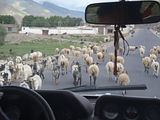
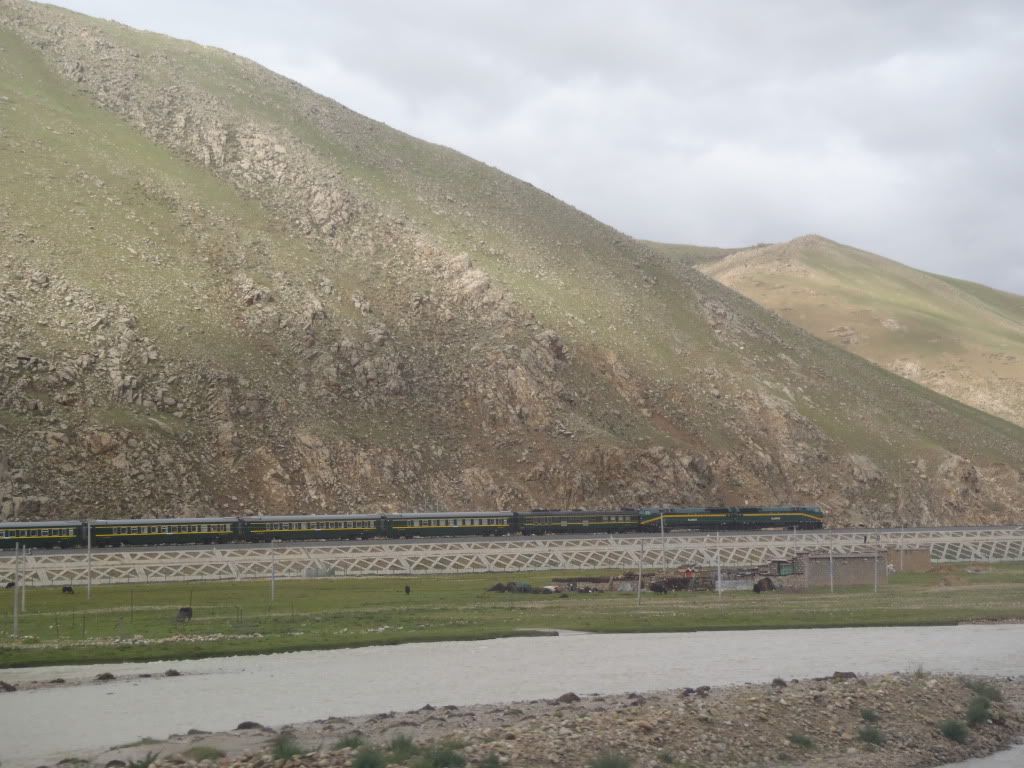
- Tibet consists of three parts: the Tibet Autonomous Region (Lhasa and surroundings), Amdo and Kham. The latter two sadly are part of Chinese provinces. Not that the T.A.R. is that much better off…
- There are only about 6 million Tibetans living in all of the regions of Tibet. Another 100,000 live in exile elsewhere on the planet (mainly Nepal and India).
- The three Tibetan provinces together are three times bigger than France.
- The Tibetan plateau is actually a pretty poor place to grow things. The height, lack of water and cold prevent the production of rice. It’s no surprise the staple food is roasted barley (called ‘tsampa’), along with most yak products. Introduced foods such as potatoes, tomatoes, cabbages, radishes, onions and garlic can now be grown as well, but have obviously not been around for very long.
- On the other hand, 47% of the world drinks water from a Tibetan source.
- A mere 2% of Tibetans own a car, with the far majority of those driving in Lhasa.
- Only 5% of all Tibetans have access to (Chinese-controlled) internet.
- Older generations of Tibetans have been very disillusioned by the past decades; it’s the younger generations that brought back a revival of Tibetan culture.
- Playing children used to call ‘the enemy’ ‘Japanese;’ nowadays the bad guys are always ‘Chinese.’
- Guiding is considered a middle class job, whereas being a doctor or traffic police officer is considered much better. The former because you help other people, the latter because of the decent pay, but better bribes.
Finally, around 11:30 AM we got to see our first yaks, Tibet’s large cow-like herbivores. Since we’d already eaten parts of the yak it had been high time to actually see one first-hand. They are so much cooler than plain old cows back at home! Around noon we came across our first other ‘village.’ Horribly Chinese-looking Damshong would be our lunch-stop. A Chinese-only menu meant we had to get Ray to order us food, without knowing the prices. We ended up with a horribly overpriced nearly chicken-less spicy chicken dish and a watery soup with some lettuce in it. What a rip-off! And what’s more, Francesca really needed to go to the bathroom. The toilet-situation had already been dyer in Lhasa, but what awaited us outside of the city proved to be absolute horror. Skip the next picture if you still need to eat!
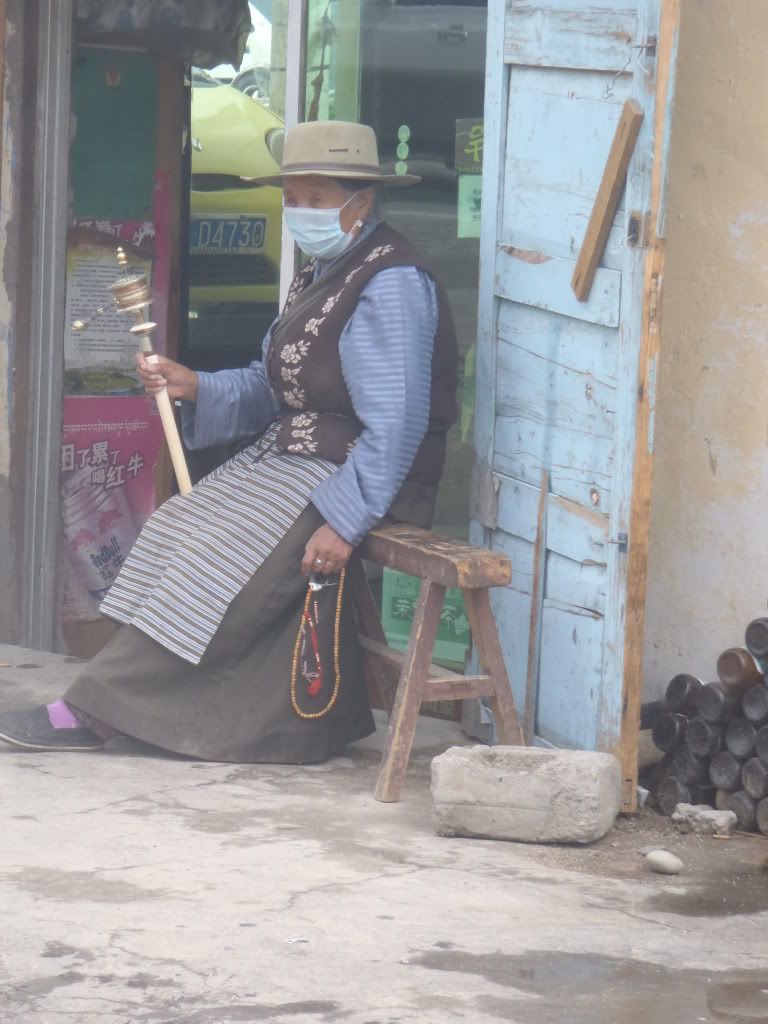
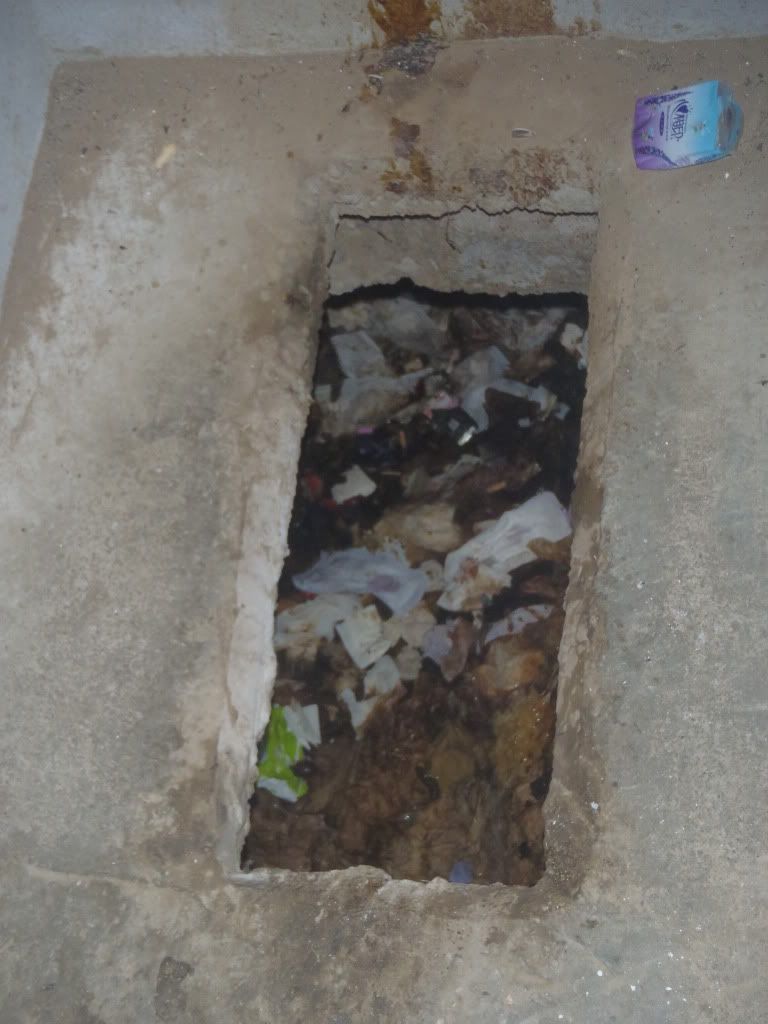
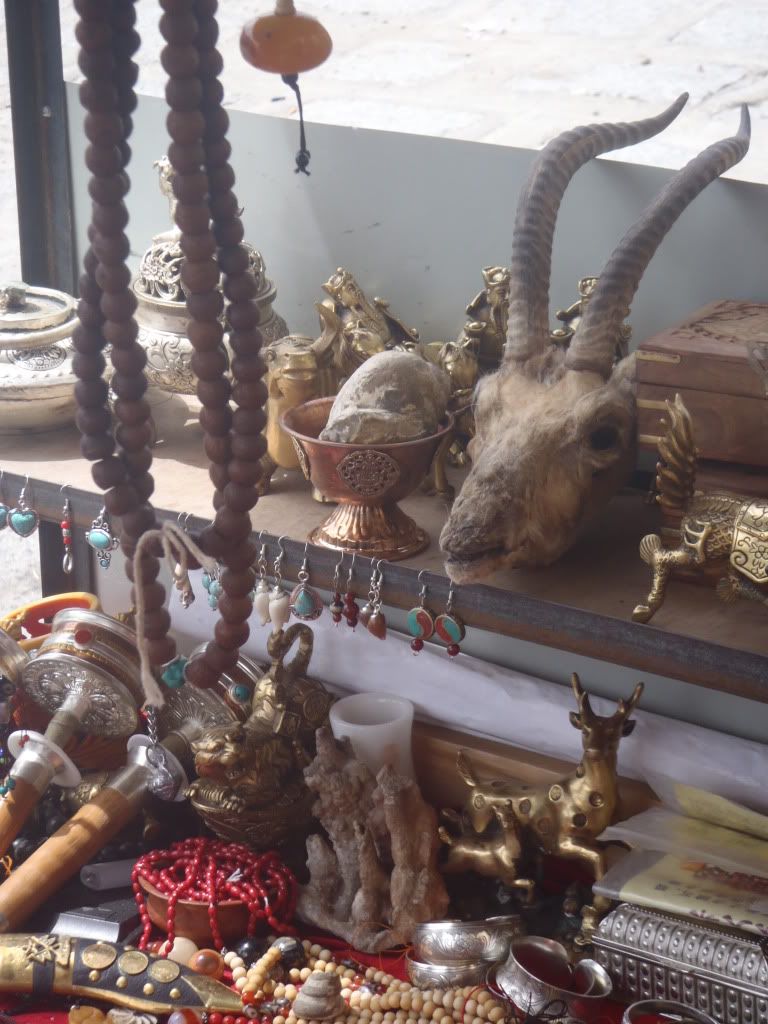
We left Damshong in a hurry, eager to finally make it to Nagchu. Since the roads have no speed radars it’s technically impossible to prevent speeding on Tibetan roads. The clever Chinese politicians decided it would be a good idea to set up checkpoints along the way and having drivers get stamps every time they pass one. They’d then have to take at least x amount of minutes to make it to the next checkpoint. If they’d end up being faster they’d be fined. Sounds smart, right? Unfortunately most drivers still speed to the next checkpoint, where they end up parking their car for some time before continuing their drive. Ray rightfully said this is actually more dangerous, since there’s no lighting by the roads, making the whole situation more accident-prone. Of course, the Chinese officials don’t care and leave the situation as is.
Our drive continued, with yaks crossing the roads, and a little bit later a stop to take some pictures of Tibetan nomads and their herd of yaks. I got out of the car to have a closer look at these beasts of burden. The first thing I noticed is that yaks are surprisingly agile animals, much more like goats than cows. Whilst they once roamed the Tibetan plateau in large herds numbers of wild yaks have dropped sharply and are hard to find nowadays. Whilst domesticated yaks are still bigger than normal cows they’re not as enormous as their wild counterparts. Wild yaks can reach a height of 2.2 meters and a weight of 1000 kg; domesticated ones are only about half that weight. Ray told us yaks are an integral part of Tibetan culture, as they are often used as pack animals for long trips. Yaks are also a great source of food, because they provide meat and dairy-products as well as insulating fur, long hair and manure – once dried a great source of fuel. I later found out yak meat is actually one of the healthiest red meats, being over 95% fat free and full of protein. No surprise with the diet of grass and all the exercise these beasts get!
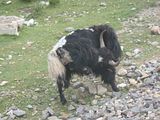
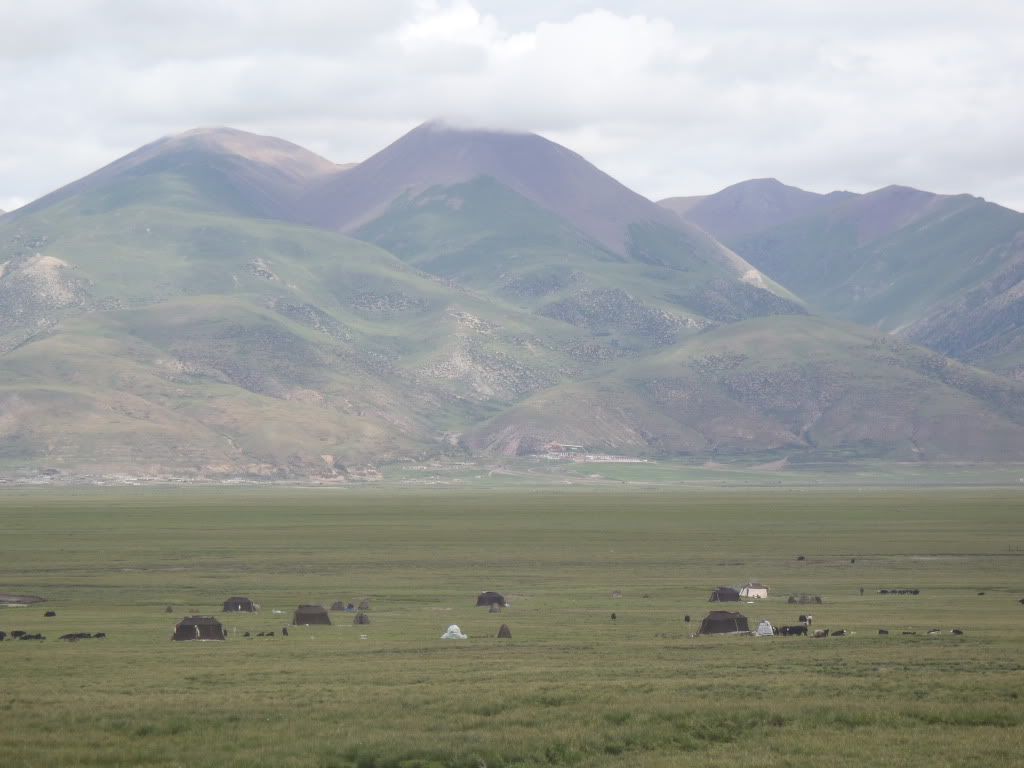
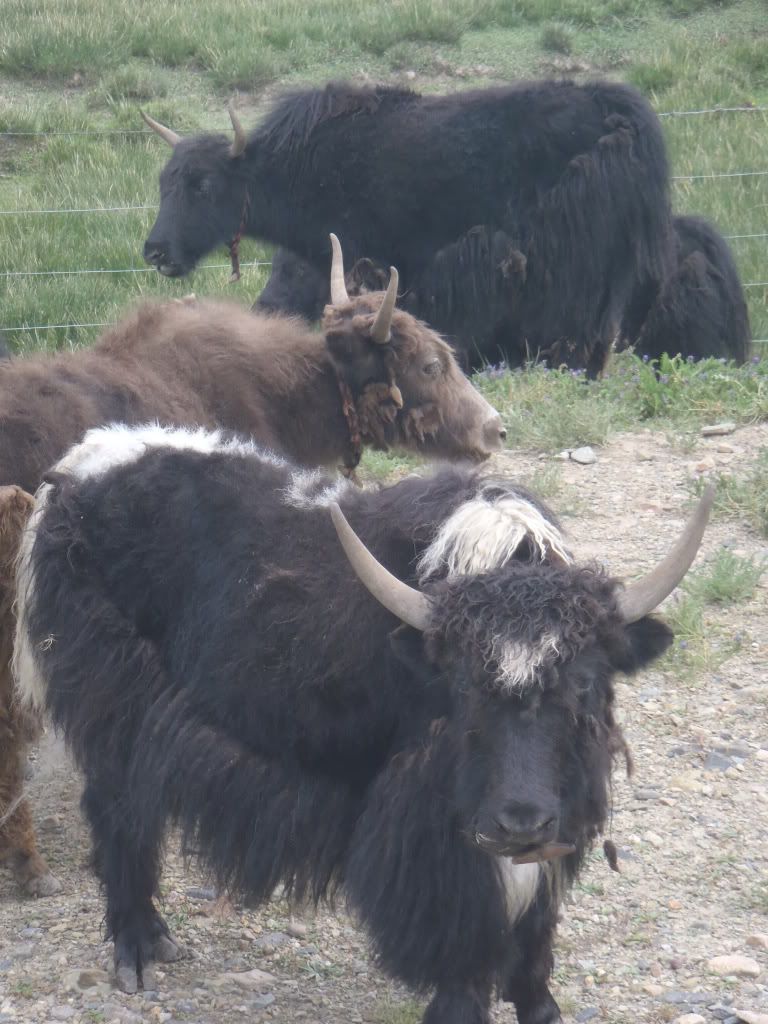
Around 3:30 PM we finally reached the city of Nagchu, perched at a height of 4500 meters above sea level, making it one of Tibet’s highest cities. Nagchu is also, unsurprisingly, one of the coldest and windiest cities in Tibet, with oxygen levels just 60% of those found at sea level. Suddenly my shorts weren’t quite as nice anymore! Our first task was to find a hotel for the coming two nights. We hadn’t pre-booked any hotels outside of Lhasa, figuring it would be easy to find accommodation. As we popped into a few places Ray and I found out it’d be much more difficult and pricey to find something here. Most places had been booked up by tour-groups and other visitors… After 30 minutes of driving around Ray finally found a place that would discount their room enough for us to accept the offer. We lay down for a little bit, because we both suffered a little from the height and thin air.
Around 4:30 PM we met Ray once again, this time to go check out the festival. A short drive took us to the parking area, where we said goodbye to Power and walked towards the terrain proper. We were met with looks and stares by the locals. Not quite as annoying as the Chinese, but still quite awkward for us. As we passed a large number of tents – apparently housing as many as 10,000 nomads – a large arena appeared in front of us. Ray told us we wouldn’t be able to get in without a special ‘Tourist Card,’ which we could only obtain from a police officer. It didn’t take too long for one to show up. The kind man told Ray the festival had pretty much ended for the day, so we would be allowed to check out the last bit for free and only had to pay for the next day. Very kind! We thanked the man thoroughly and headed for the arena.
The three of us climbed a few stairs and sat down in the large stadium. The first thing I noticed was the gorgeous view. Behind the stadium the grassy hills were being grazed by a herd of yaks, and above it the blue sky carried a few large, white clouds with ease. Around 5:00 PM some dancing ensued, which Francesca found interesting, but left us both wondering how traditionally Tibetan it was. We watched for about 15 minutes after which the show ended and we got to make our way back to the hotel. Francesca had attracted two fans during our stay in the stadium: two girls kept on following her. I tried to take a picture of them, but they were a little shy. Ray told us Tibetans tend to be okay with having their photo taken, unless you ask them. They’d rather say no if you ask. Having been on the receiving end of this deal quite a bit in China we both felt uncomfortable just pointing our camera at the Tibetans.
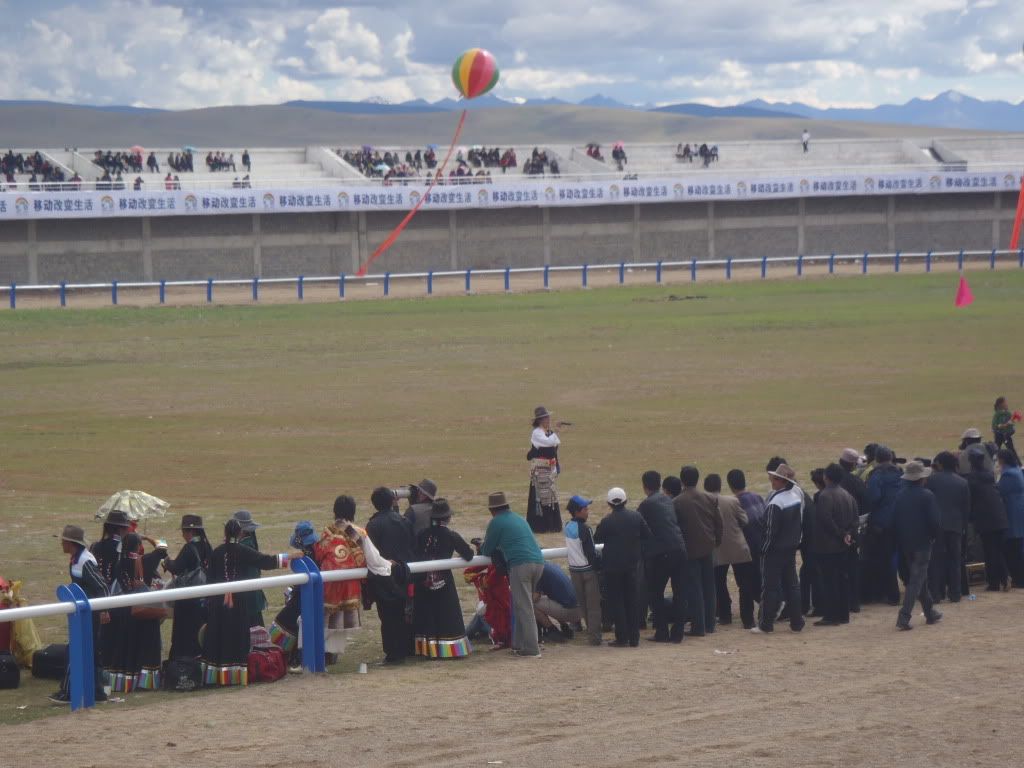
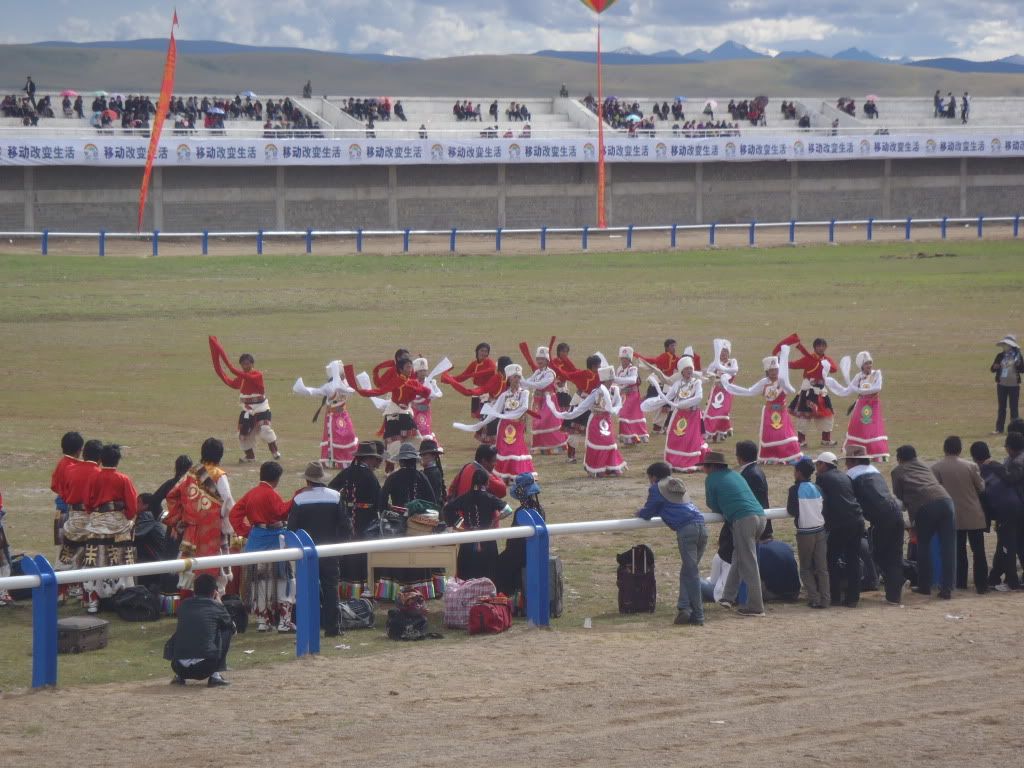
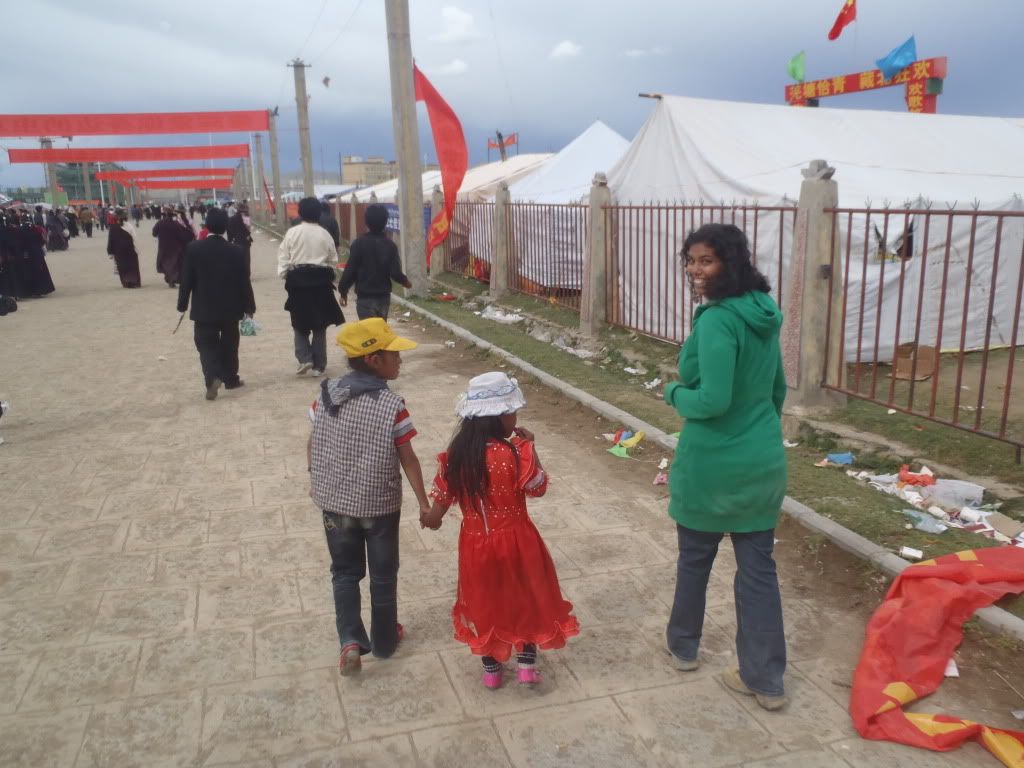
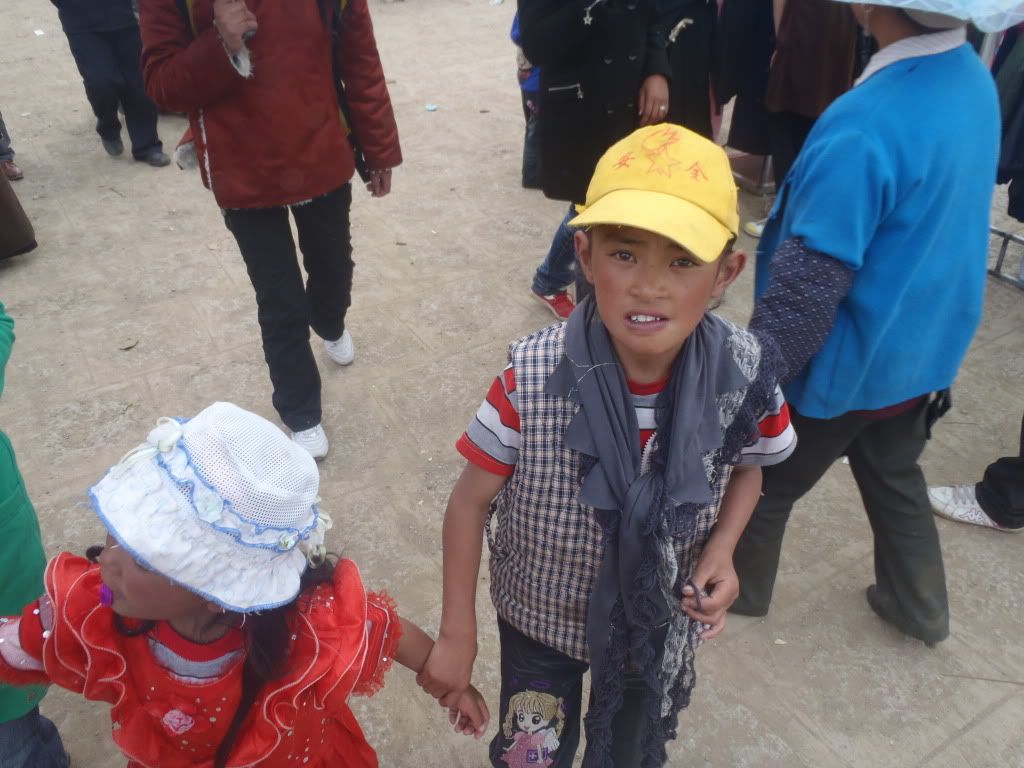
That evening I ordered Francesca a sweet and sour chicken, and myself a noodle soup and some steamed buns. After a good 45 minute wait an enormous plate of chicken arrived, along with a small bowl of soup. Francesca gorged on the delicious chicken whilst I had to make some chicken sandwiches to satisfy my appetite. We watched one of Francesca’s childhood movie favorites ‘Pete & His Dragon’ with our food on our laps. Unbeknownst to both of us the plate of chicken ended up leaking on the white sheets, leaving a huge, orange mark that I could not get rid of. Fearing a fine we hid the sheets and replaced them with some extras we’d found in the closet.
Sleep came easy after the tiresome drive and altitude gain. The next morning we had a shower and met Ray around 9:00 AM for a full day at the festival. The program offered a variety of horse racing, weight lifting, singing and dancing. Sadly we’d have to miss the yak racing, something I would have loved to see. Regardless, the program promised plenty of variety. However, before sitting down for the entertainment we needed sustenance. Ray led us inside a large nomad-tent, where we could choose between yak momo and noodle soup. Of course we chose to have the lady make us some hand-made momo. Ray joined us in our yak eating feast and finished a plate by himself as well.
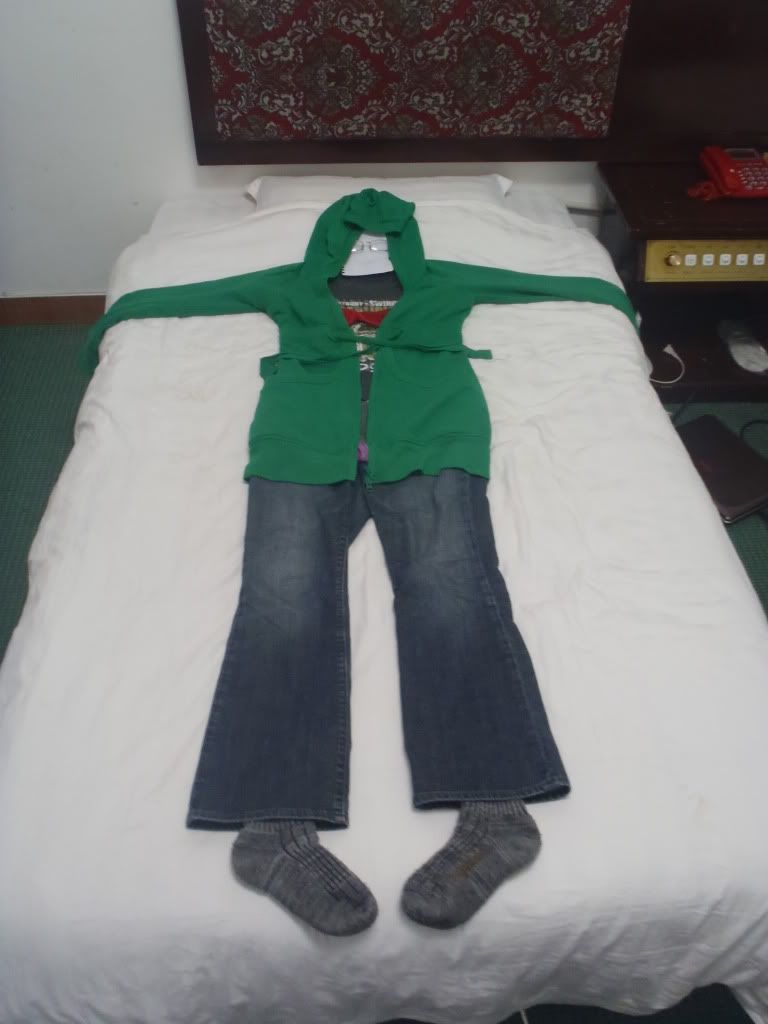
Around 9:30 AM we found our spots and joined all the locals on the concrete benches of the horse racing stadium. Throughout the day we took pictures of all the colorful Tibetans that had decided to come see the show as well. It was great to see how some were in full traditional outfits, whilst others wore completely modern, even hip clothing. Of course the Chinese army was also present, obstinately parking a row of soldiers in the middle of the field, with patrols going around the stadium and fully armored riot police on stand-by. Complete overkill and frankly quite scary for the poor Tibetans that all just came to enjoy their tradition.
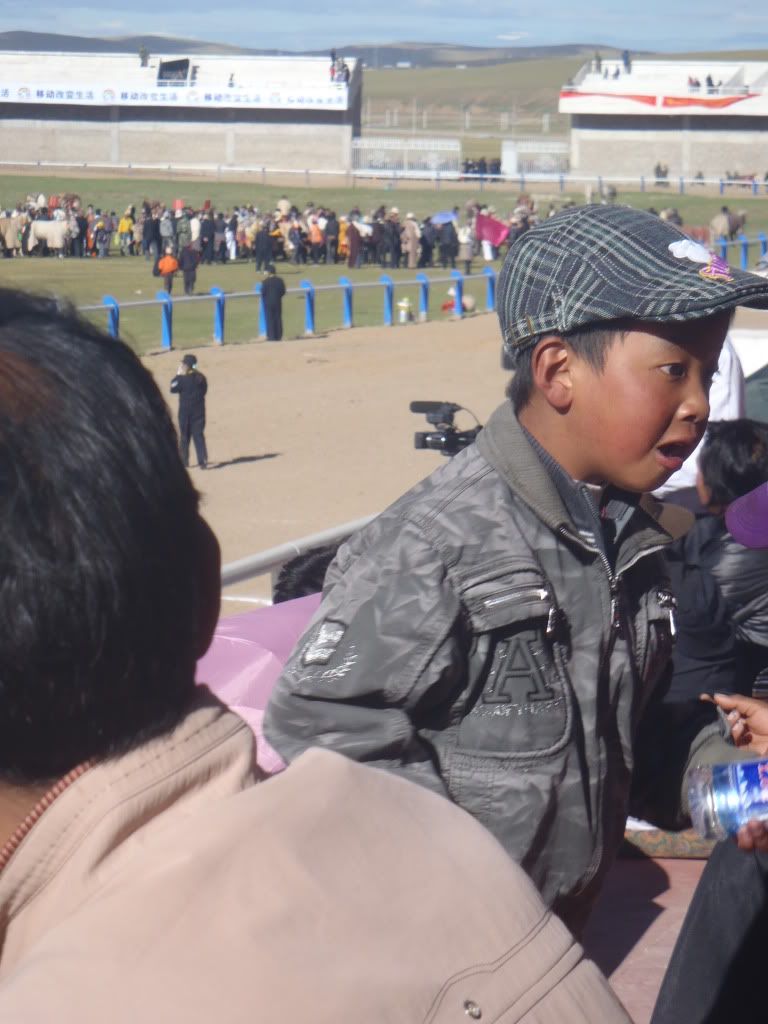
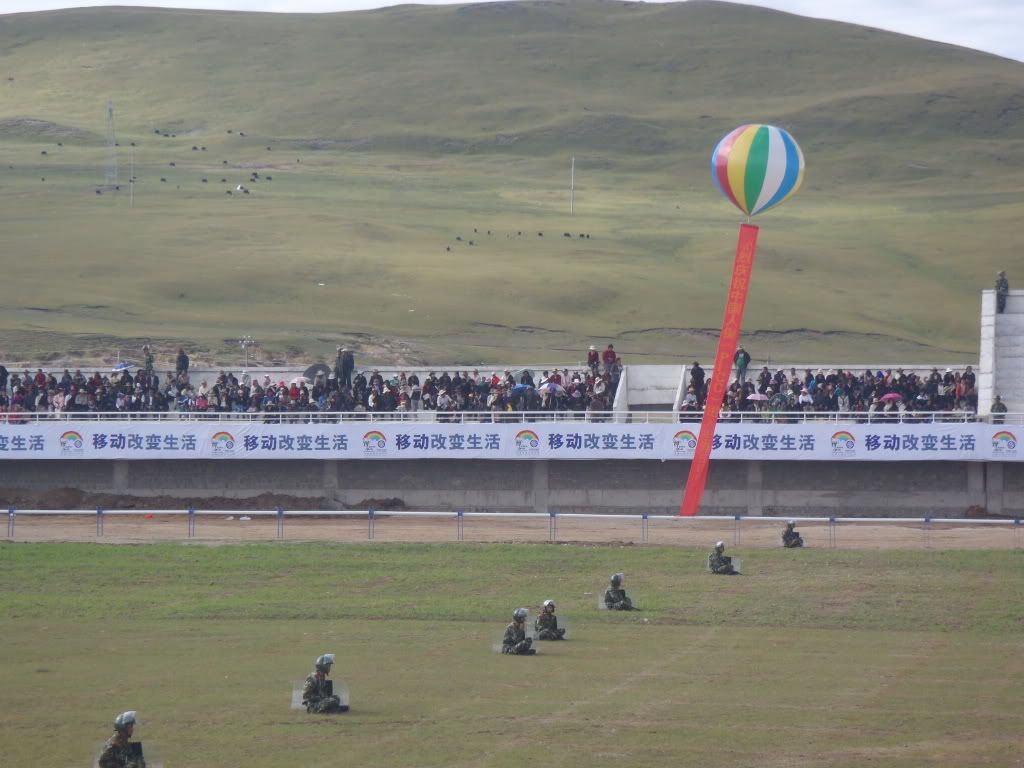
Here’s a little description of the history of the festival from chinatravel.net: “In the 17th century, the Horse Racing Festival was established as a way to bring the area's nomads into the young township to exchange ideas, inventions and goods—a kind of nomad Expo. Within the next century the gathering had become the most popular and important event of its kind in the Northern Plateau. Little changed for almost two hundred years in and around Nagchu, until the Cultural Revolution hit Tibet and the culturally significant Horse Racing Festival was banned. The festival has recently been revived, delighting increasing numbers of tourists every year along with the remaining nomads, many of whom are as likely to roll into town on a motorcycle as they are to arrive on horseback.”
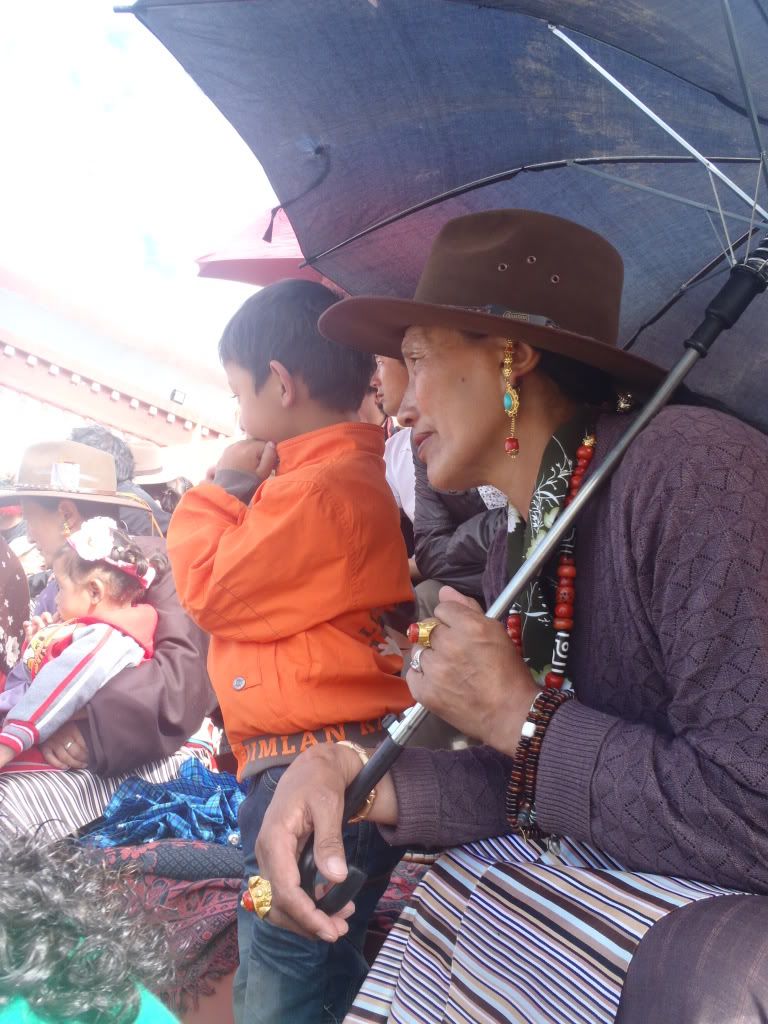
After a mandatory and long introduction in Chinese and Tibetan the horse racing got underway. Groups of about 10 colorfully decorated horses and their equally colorful, prepubescent riders were brought out onto the track and somewhat haphazardly released to race each other around the roughly 1 kilometer long ring for three rounds. Ray told us there’d be about 12 races, after which the winners of said races would go head-to-head for the grand prize. The three of us watched the races with great interest – Ray had only been here once before – seeing some close finishes. Other races saw serious crashes, one of which had a horse and its rider crash into one of the giant balloons that’d been put up all around the track. Some races seemed to have clear winners, but ended up being reset as horses tried to exit the track through a gate on the east-side of the track. Gasps would surround us as people got up to see what was going on. Once the winner crossed the finish line designated guys would run after the victor to give him a scarf and take him to the winners’ area. Of course the horses would still be going at full speed, leaving the men running after the horses for quite some time.
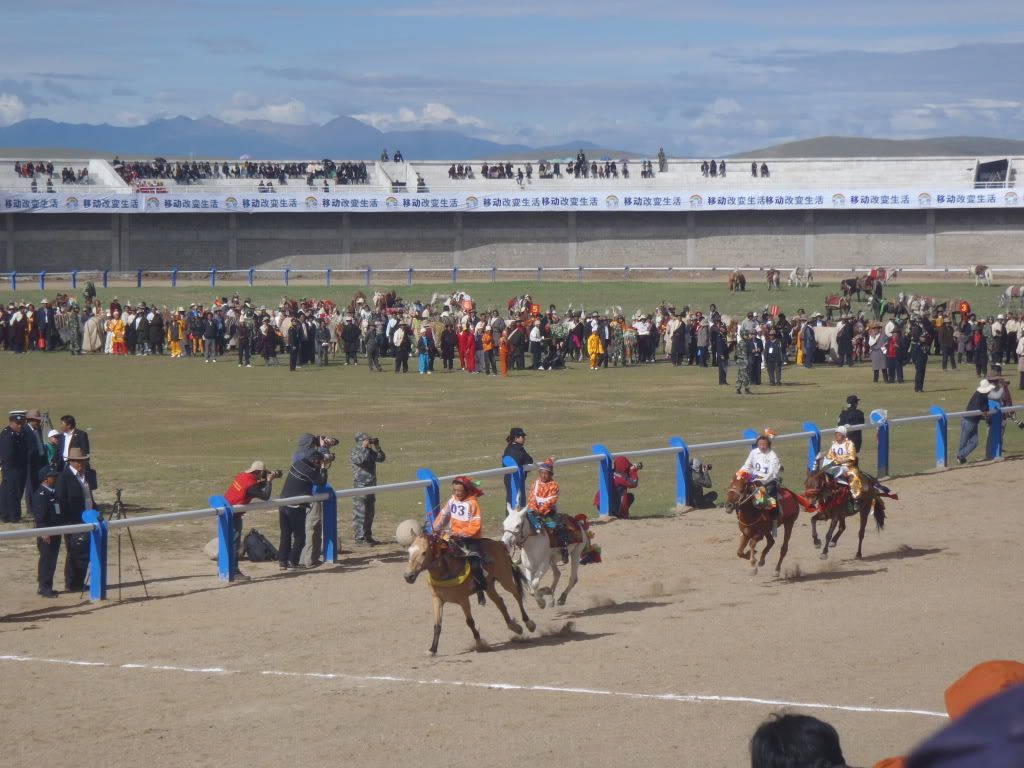
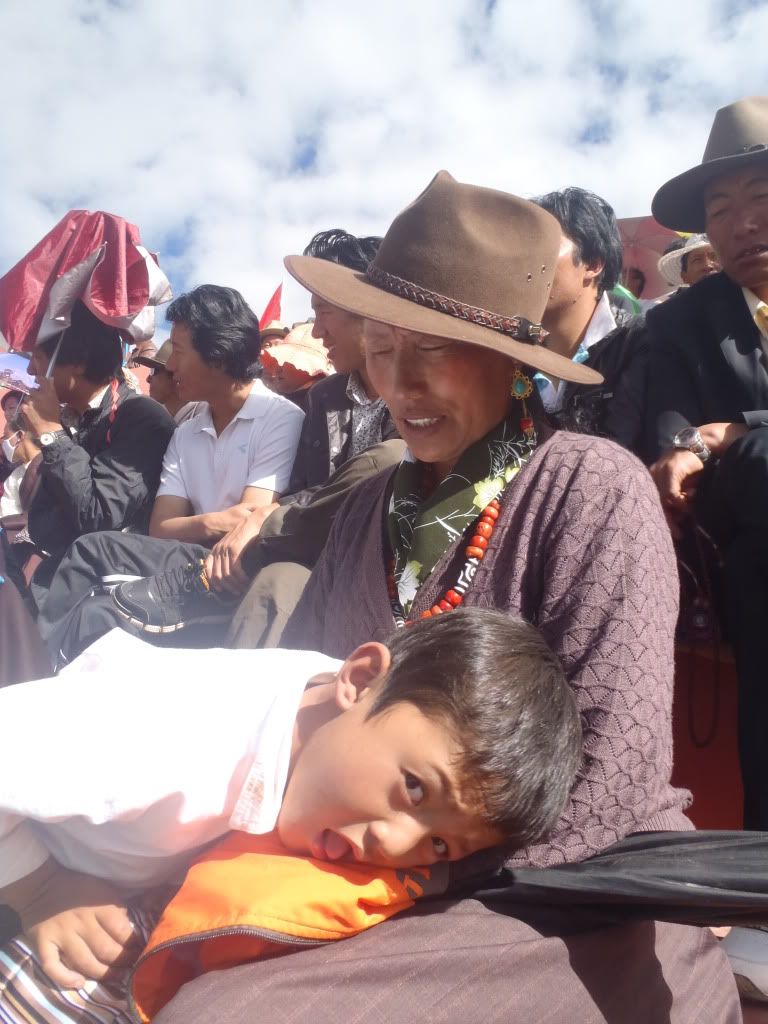
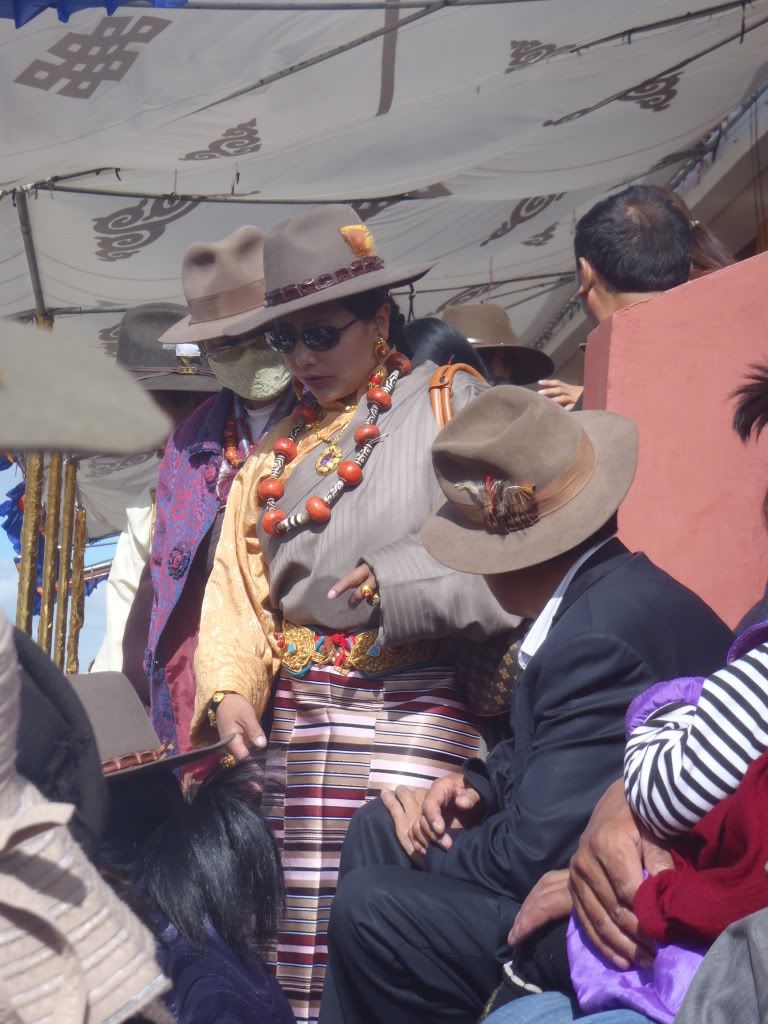
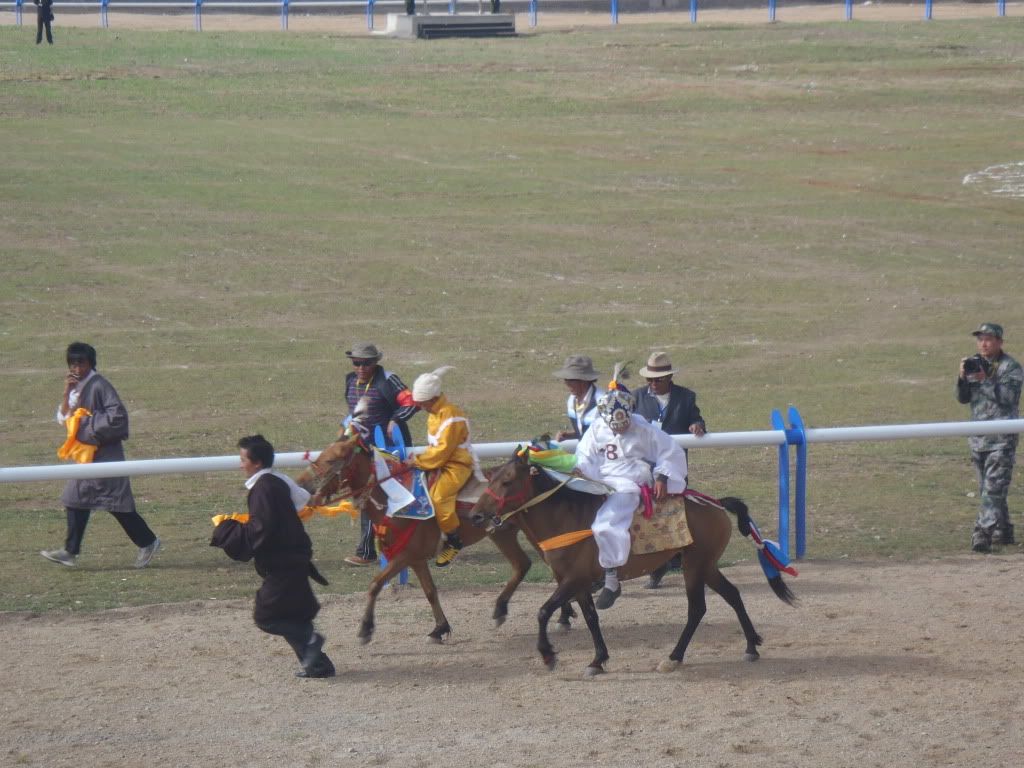
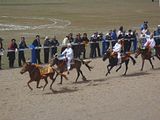
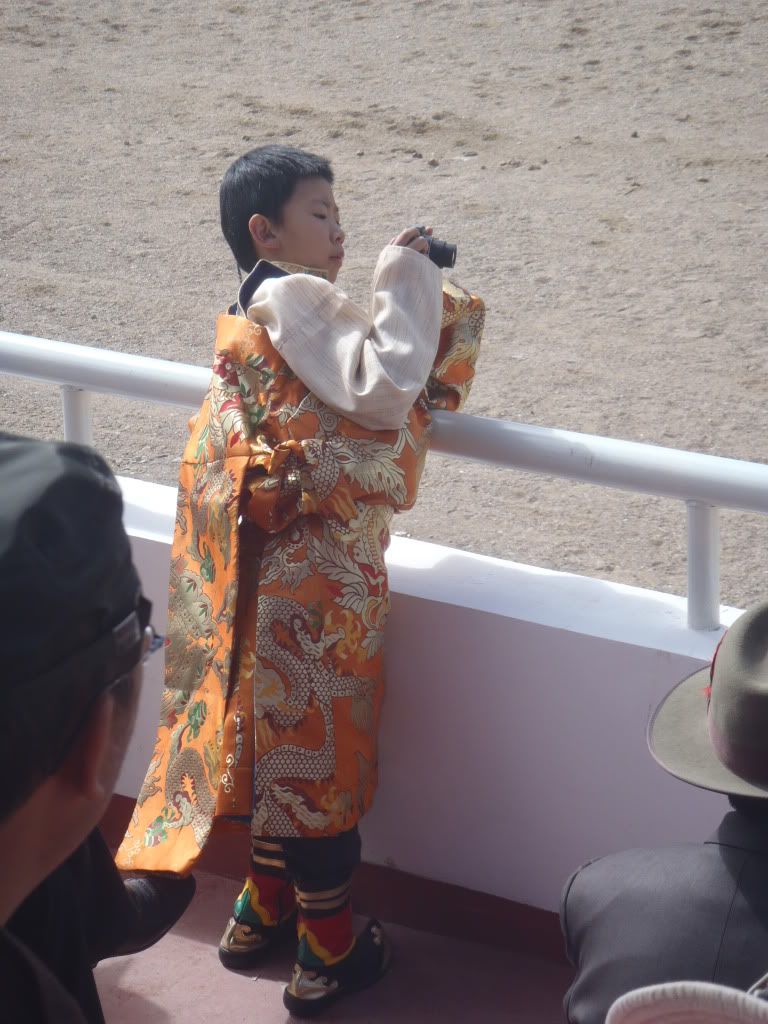
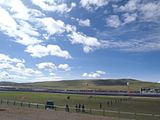
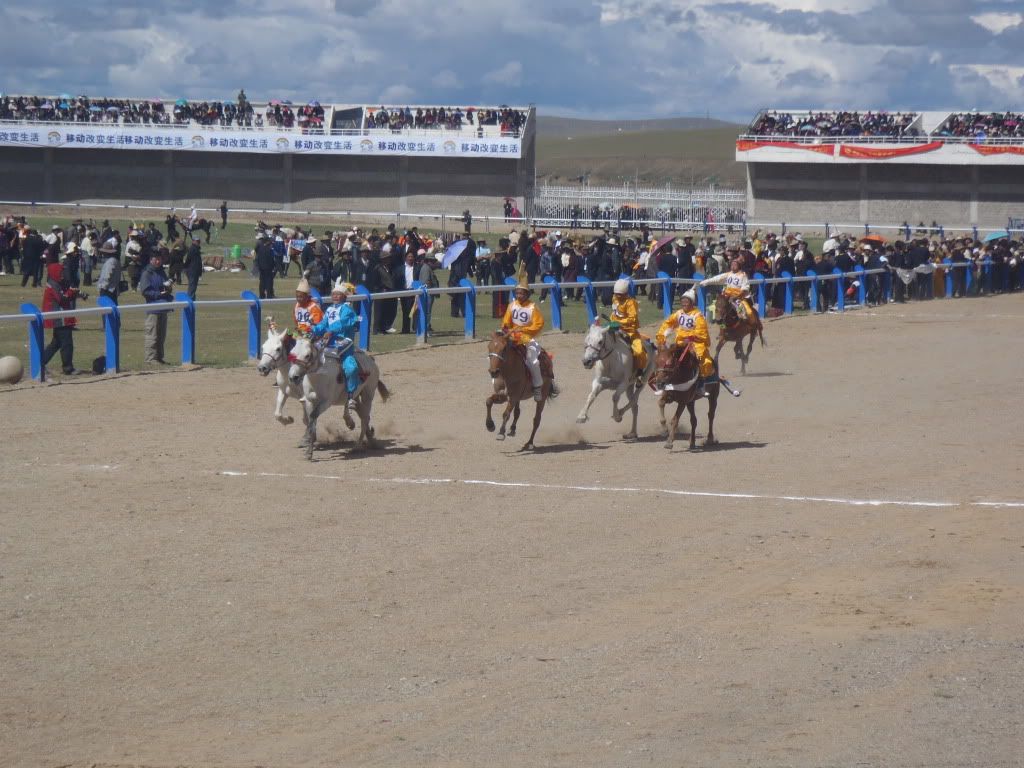
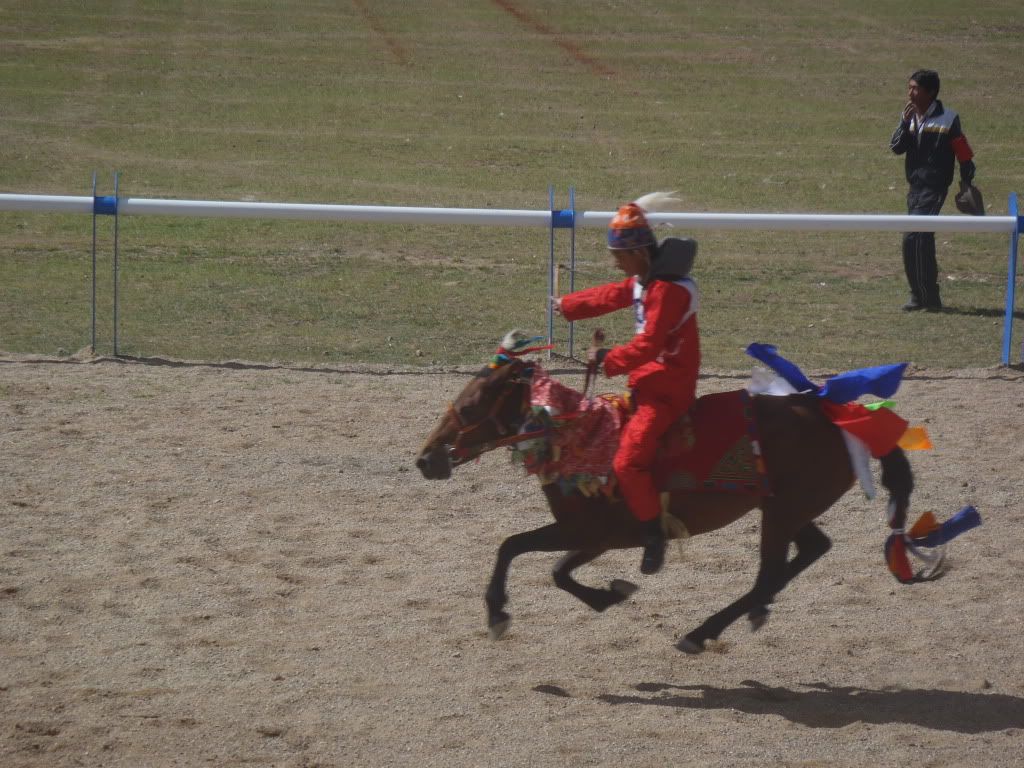
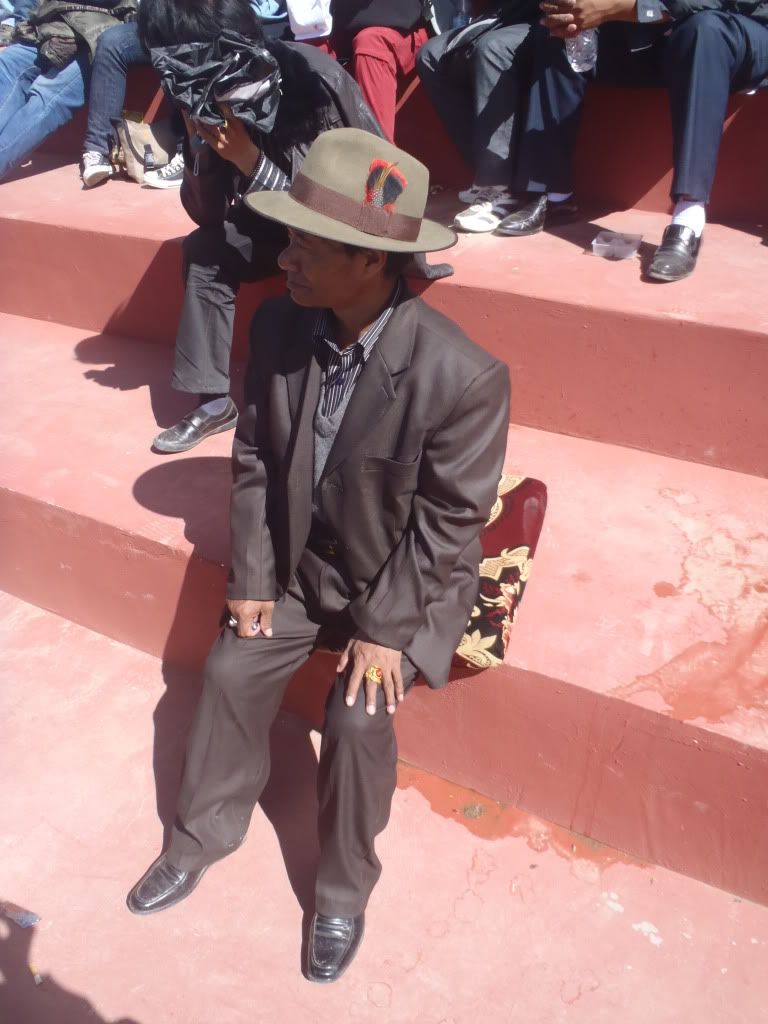
Around noon all winners had been gathered in a separate area. The organization had wisely decided to take down the balloons. One of the people taking them down had a less than firm grasp on the cord and let the giant balloon go. Up, up and away! Just before 12:30 all the winners were gathered for the finale of the horse racing. I went down to the railing for a premium view of the race, making a video and taking many pictures of the great race. A group of about 6 horses stuck together for most of the race, even all stopping at the gate, only to continue their race a little later. A few minutes later rider 14 emerged victorious, winning his family great honor and a cool, new motorbike.
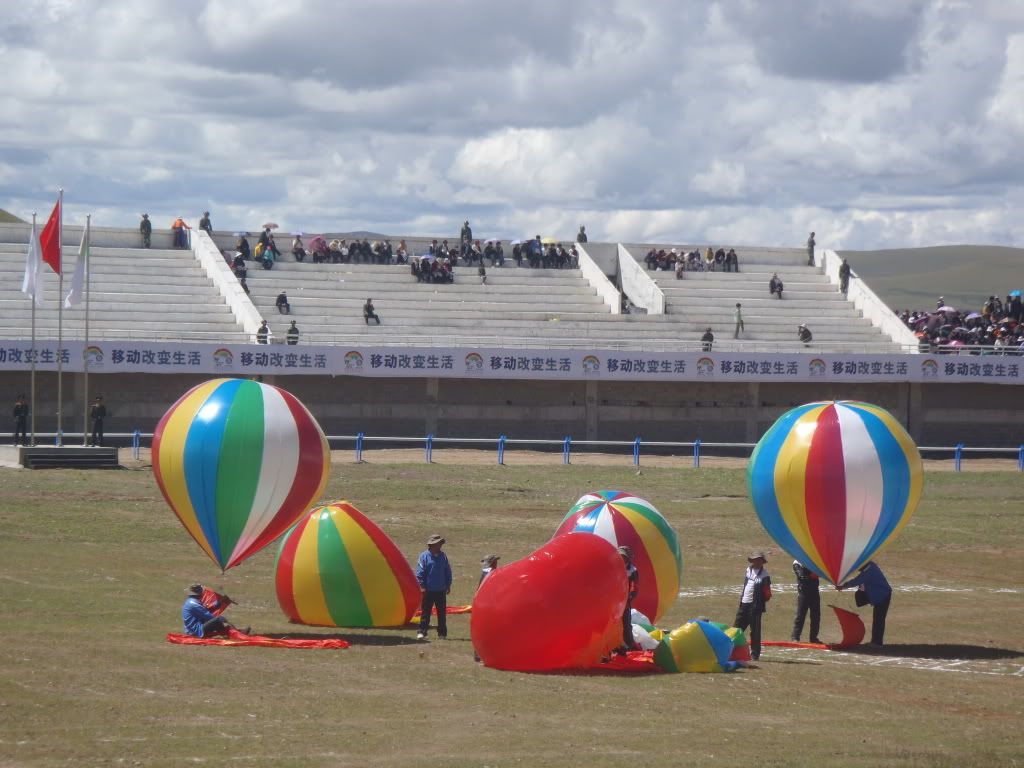
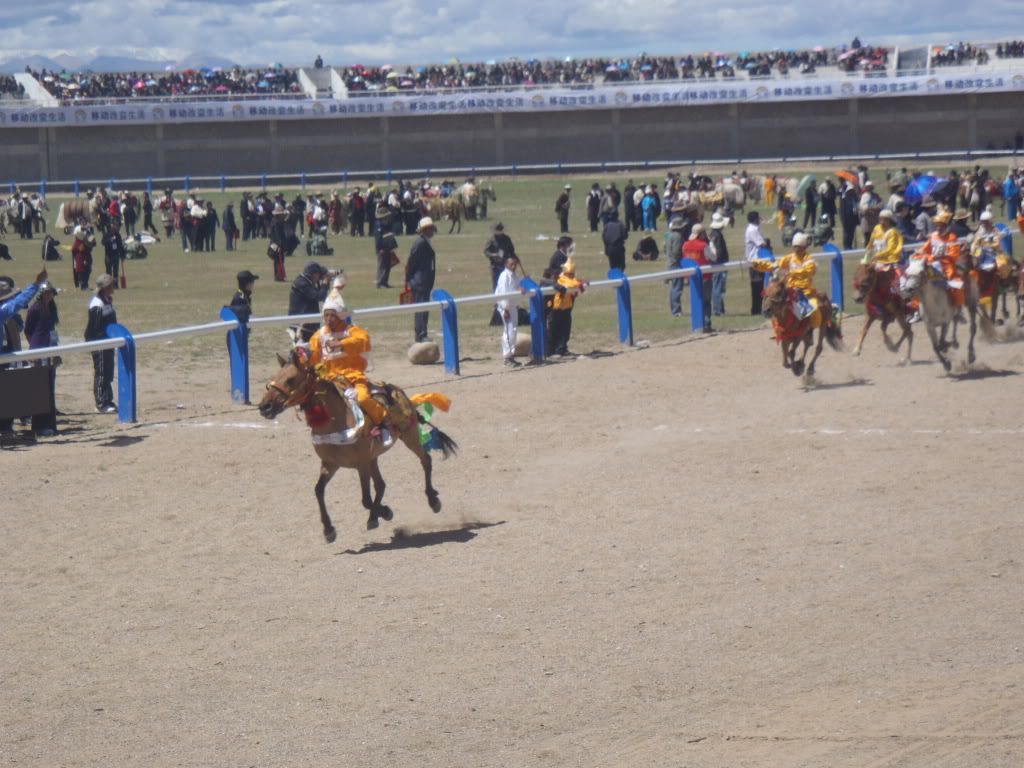

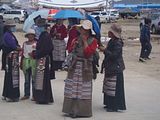
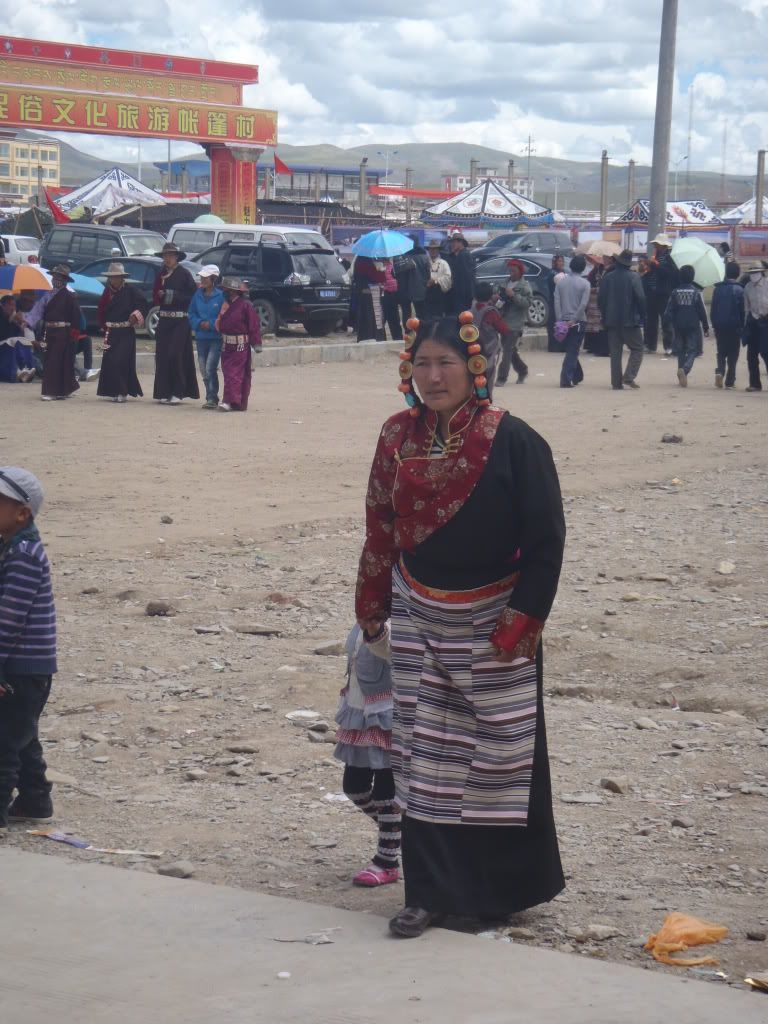
A break followed as the stadium was emptied of people, who all went their own way to score a meal. It was unknown to both Ray and locals he asked what time the weight-lifting would start, which made us wonder if we should head back to the hotel, or stay around the festival for lunch. Ray and I ended up eating a momo soup in one of the tents, whilst Francesca skipped that meal hoping for something better. We eventually found her a bag of popcorn, skewered potatoes and meat, which we combined with some buns I’d already bought for her.
Ray, in the mean time, had dozed off on the steps in front of the stadium. There was no information available about the schedule and nothing happened for a long time. It took until 3:00 PM before the gates were opened again. Sadly, there’d be no weight-lifting… just more dancing and singing. I listened to the lengthy introductions, followed by some awful Tibetan singing, and equally bad dancing. Francesca and Ray were a little more interested. I handed over the camera to my girlfriend and walked off to stand in the shade for a while. Immediately some of the security wondered what I was doing, so I rubbed my legs and belly, indicating I was stretching my legs and had a bit of a stomach ache. After half an hour I returned to Francesca and Ray, who’d been watching all the dances. I sat down for the last 5 minutes and hoped for a speedy end to the visual agony. Then, out of the blue, a cop appeared, pointing at me. An English-speaking Tibetan came and sat next to me asking me if I was okay. Apparently they’d thought I was in bad shape and called for a doctor! I reassured the man I was doing okay and they left again. Ray told us a tourist had fallen very ill during one of the previous years, so the staff had been instructed to check all foreigners with apparent problems.
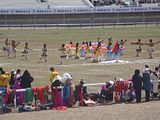
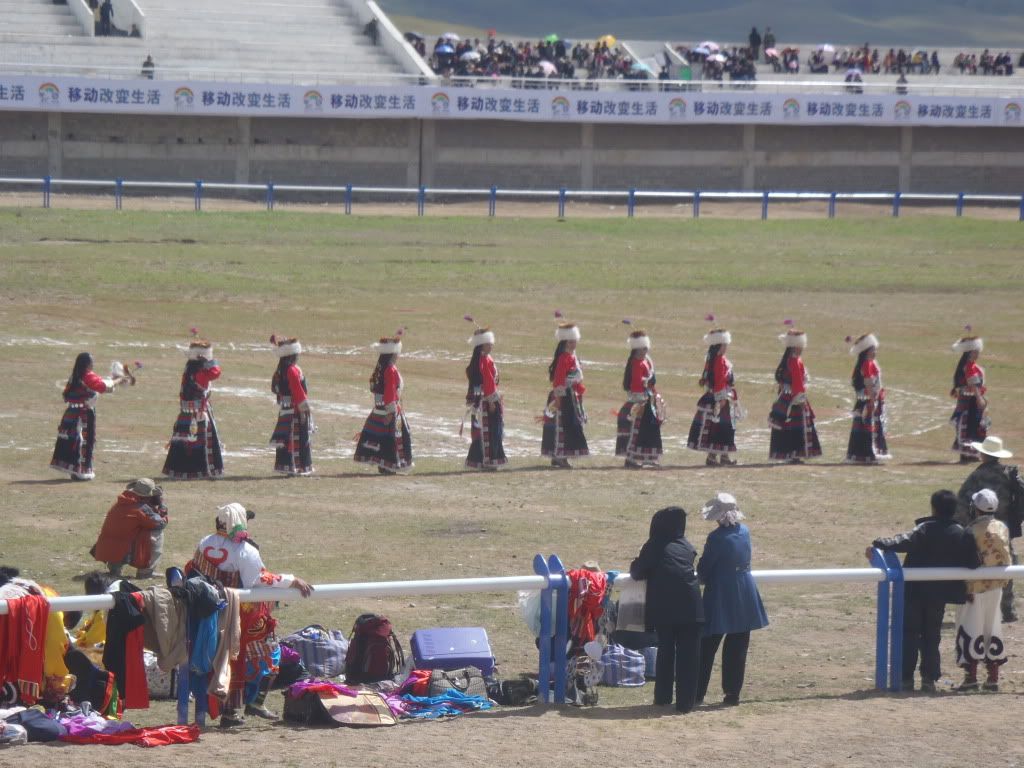
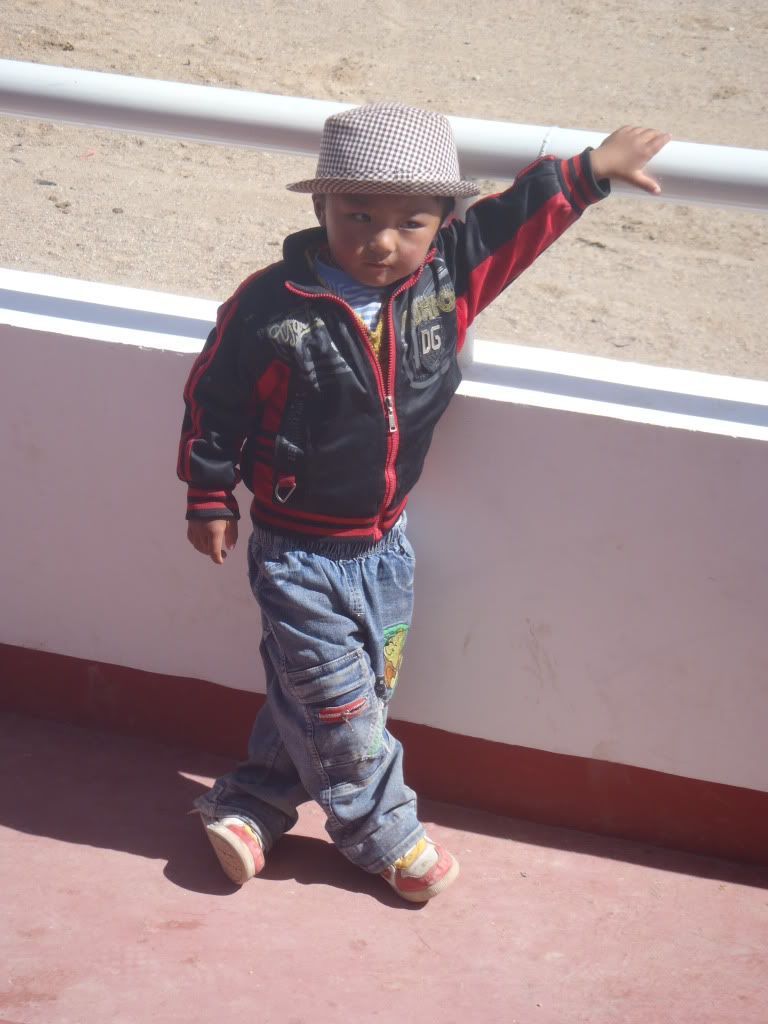
Around 5:00 PM we left and headed for the hotel. Francesca and I fell asleep for a while, only getting up to order another portion of sweet and sour chicken and steamed buns for dinner. Another enormous plate arrived around 9:00 PM, after which the bags needed packing and the two of us needed sleep.
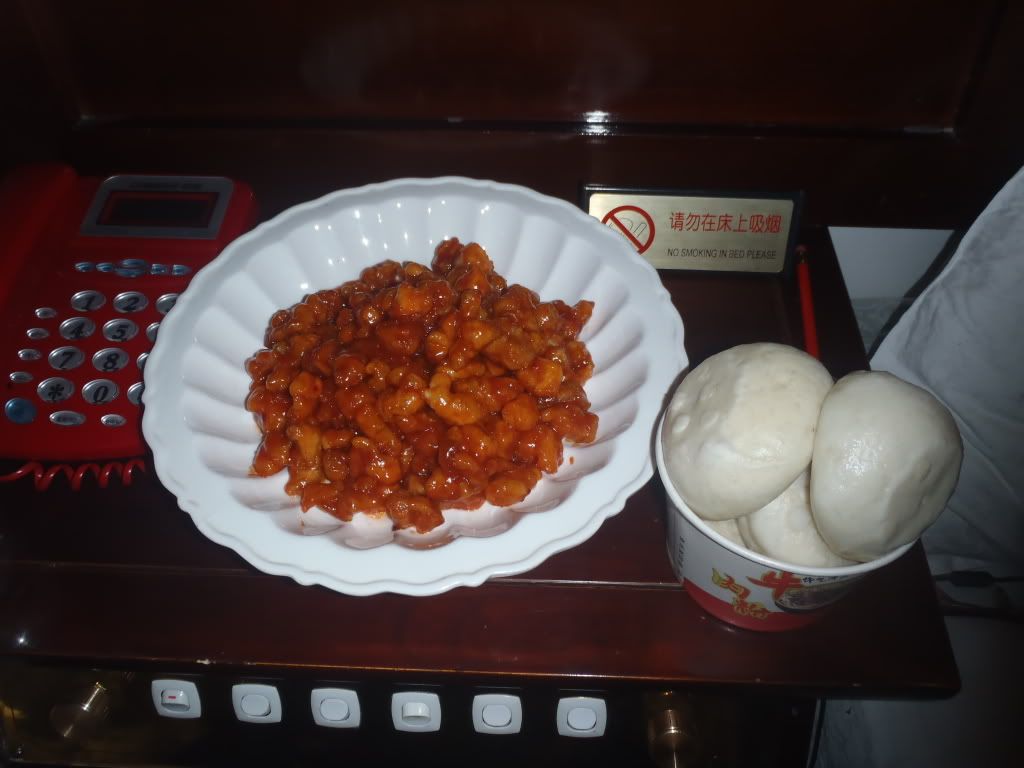
The following morning, the 13th of August would see us driving back to Damshong. From there we headed west to Nam-tso Lake, our next destination on the itinerary. Again with mountains on both sides of the road the drive took us higher and higher. Tibetans place prayer-flags along windy passes to fill the air with the printed Buddhist mantras, gaining some free merit in doing so. We stopped near one of the larger prayer-poles and I ran out to take some pictures from inside. Standing amidst the flags, looking out at the world was impressive and made for some great pictures. I even found an abandoned Chinese police-hat that sadly no longer had a badge.
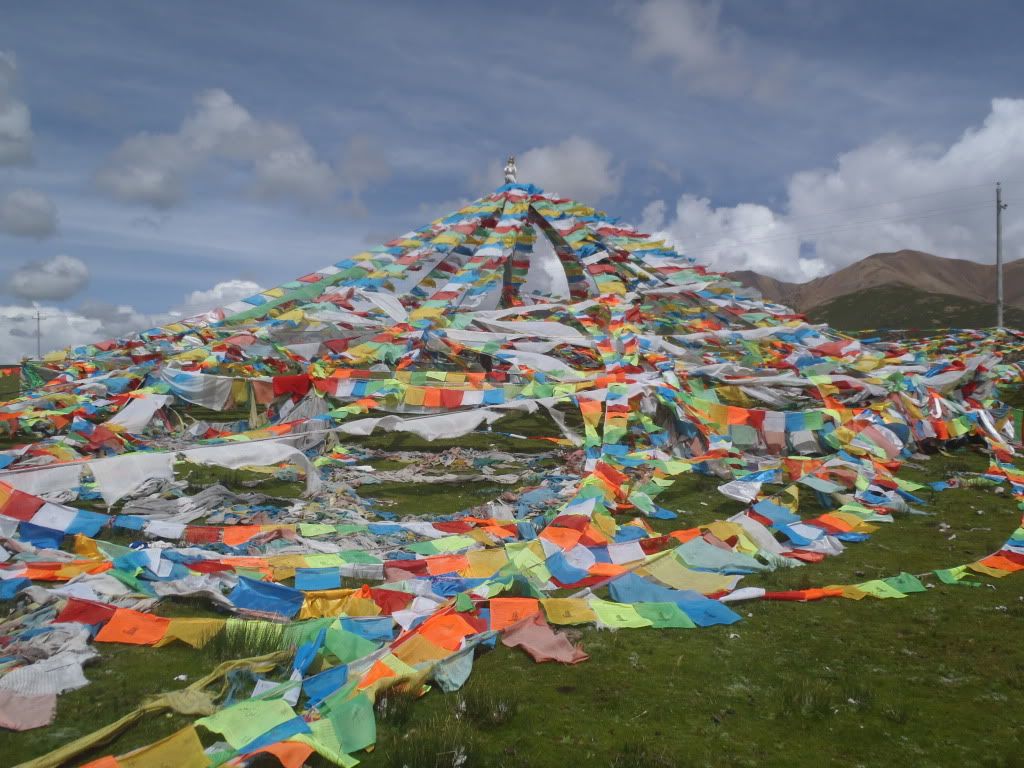
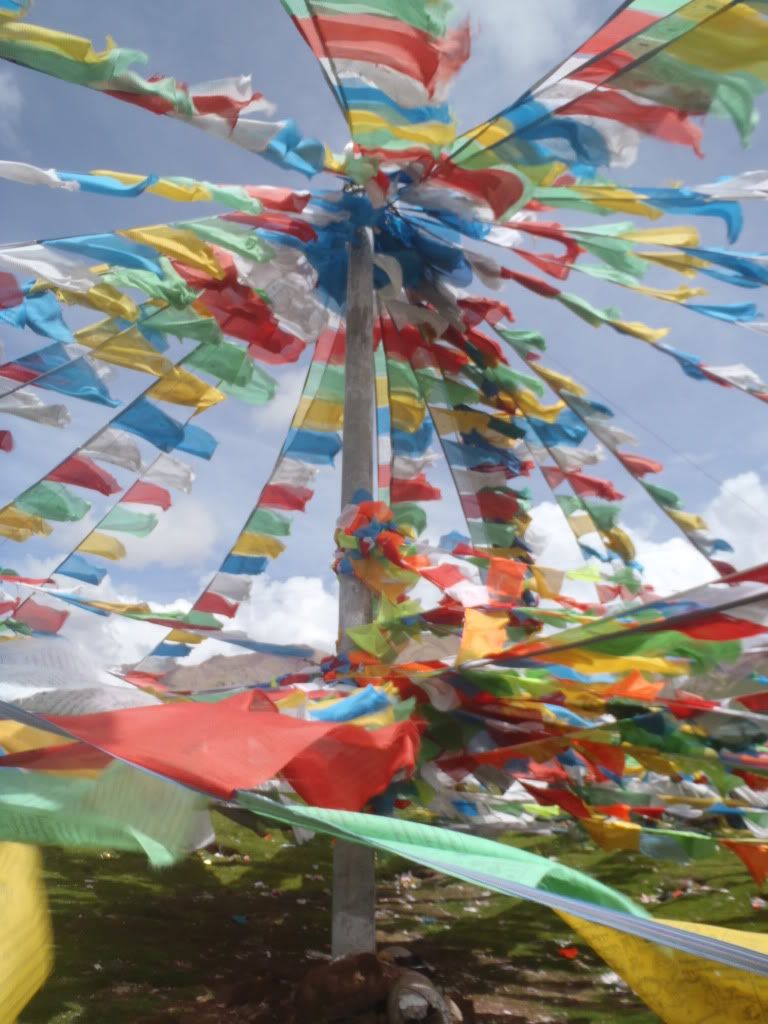
Around 1:00 PM we reached the entrance gate to the Nam-tso area. The pricey tickets had to be bought, leaving us with the bitter taste of knowing we were supporting the Chinese directly by buying them. 15 minutes later we’d reached the Nagenla Pass, the highest point of this day’s drive at the dizzying altitude of 5150 meters. I got out of the car to take some pictures of the lake in the distance. Unfortunately my shorts now really proved insufficient and I had to run back to the car to warm up. Going downhill the enormous lake came closer and closer. We learned from Ray that Nam-tso (‘Heavenly Lake’) covers an area of 1920 square kilometers, making it the second-largest salt lake in China. Furthermore, it’s incorrectly advertised as the highest lake in the world at an altitude of 4718 meters. Regardless, thanks to the altitude the sacred lake has a near-perfect turquoise color. Combined with the stunning ranges in the background it makes the whole place quite photogenic.

Just after 2:00 PM Power pulled up near some very basic guesthouses right beside the lake. Ray told us to explore the lake by ourselves, which we were fine with. I put our bags in the room, whilst Francesca headed out to find the toilet. About 10 minutes later she came back and the expression on her face told me it hadn’t been pretty. Since I needed to go as well I followed her back to the building. Just getting within smelling range of the cot made me want to run back in the opposite direction straightaway. Mother Nature was suddenly a much better option as a replacement toilet.
With that adventure out of the way the exploration of Nam-tso could finally start. We headed for a stupa in the distance. It was surrounded by a wall of rocks. At first glance they looked rather plain, but after closer inspection we noticed they’d been inscribed with mantras. On our way to the most picturesque viewpoint of the lake we passed another prayer-flag-pole, where I got some cool pictures of Francesca. We passed some people with horses and soon reached the water’s edge. A large contingent of Chinese tourists made the experience slightly annoying, especially after we some particularly ignorant Han Chinese making peace signs.
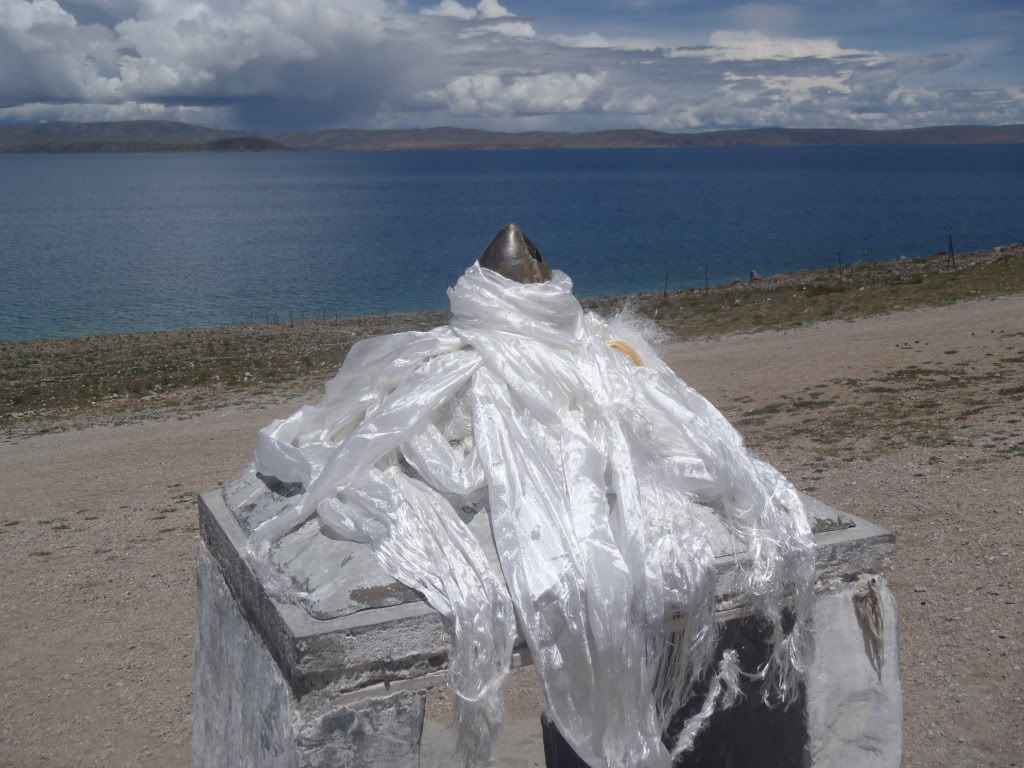
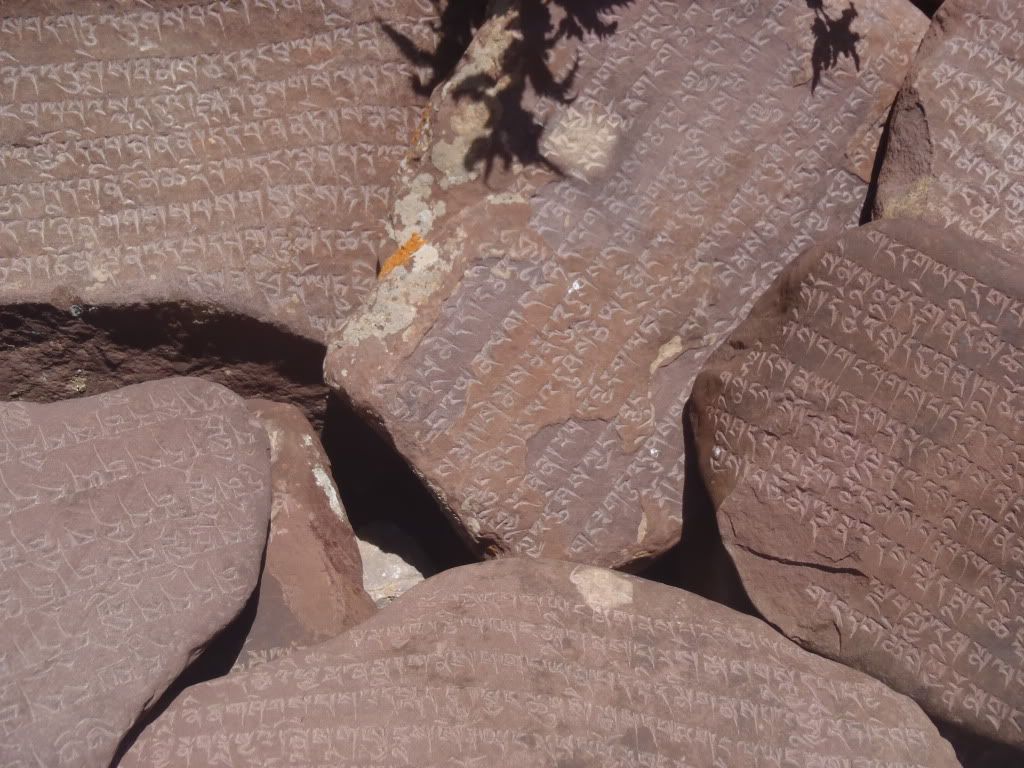
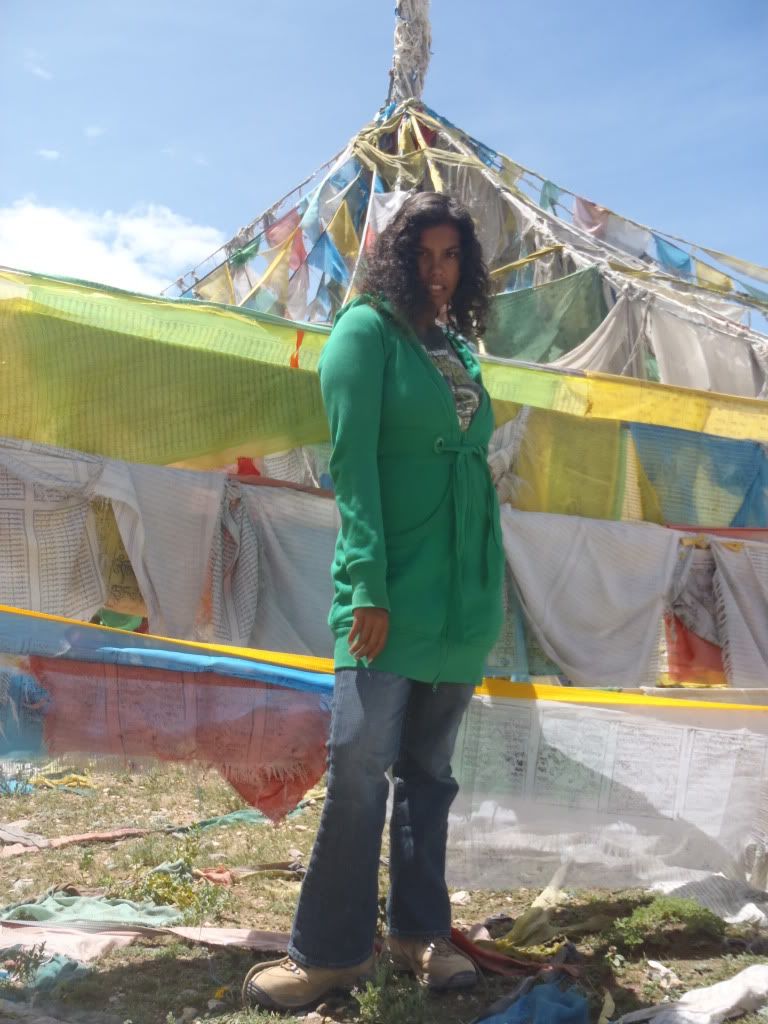
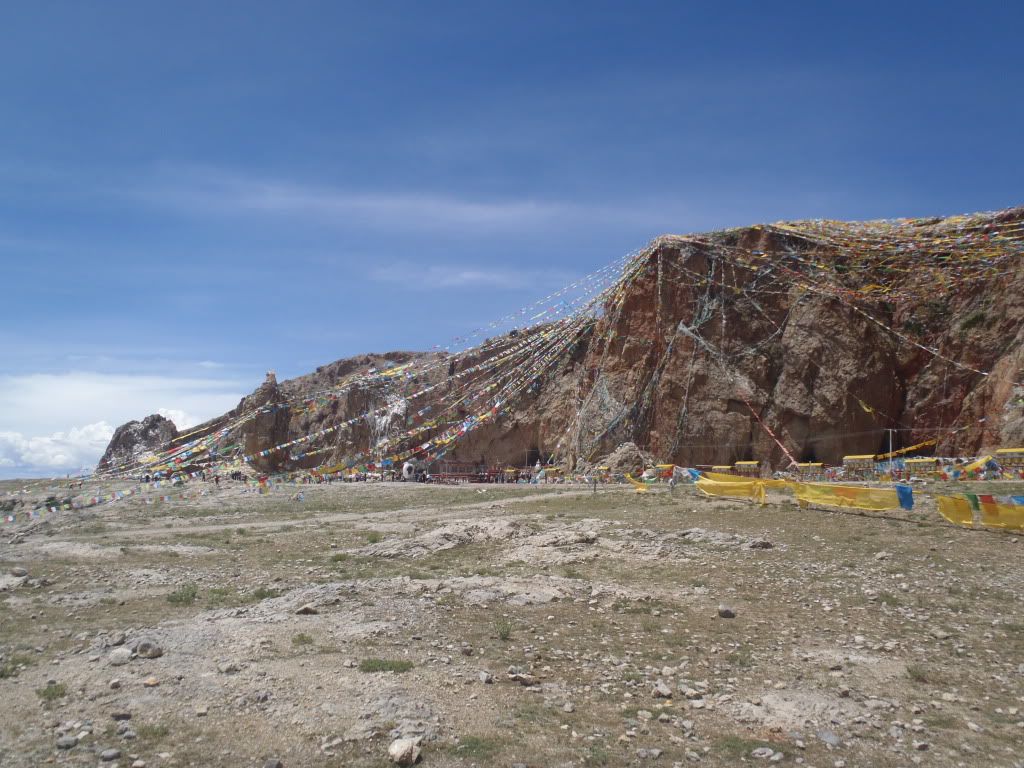
Luckily we were quickly distracted by a sign that said “Riding yak into the lake to take photos, pay 10 Yuan.” We’d both wanted pictures with a yak, so this was the perfect opportunity. With the impressive Tangula Shan mountain range in the background – highest peak 7111 meters! – we couldn’t have wished for a better spot. I haggled with one of the locals for a while to get a good price for our yak-pictures. Francesca mounted the big white beast first and I took as many pictures as I could. We then switched roles and Francesca also produced some great shots of me.
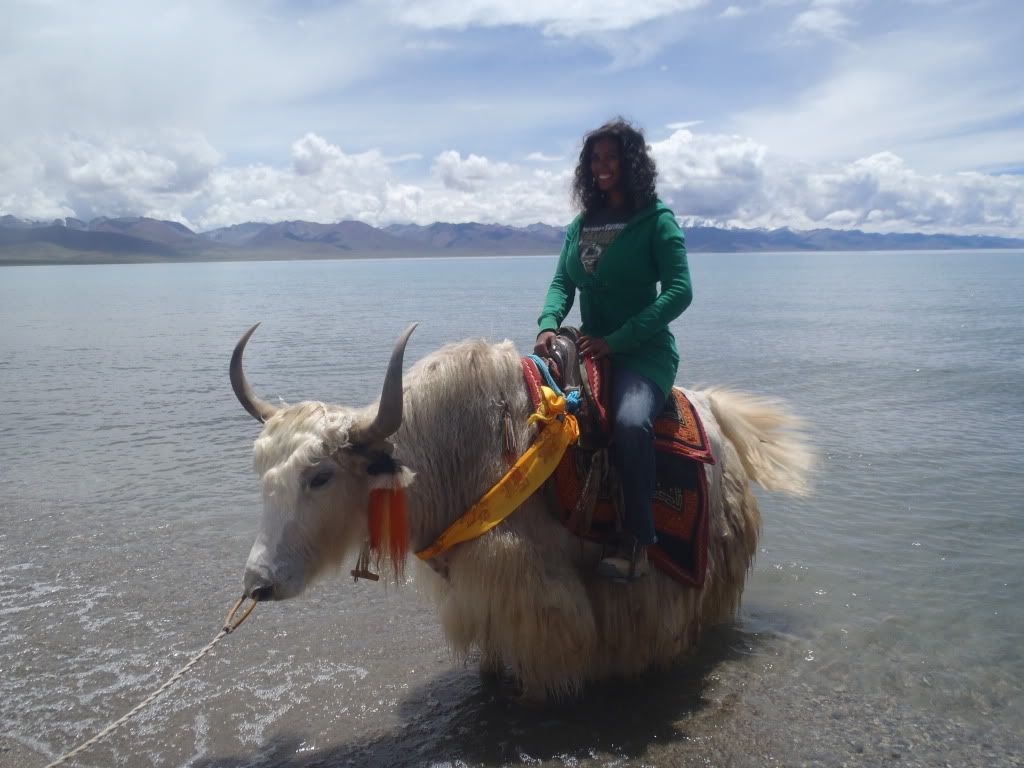
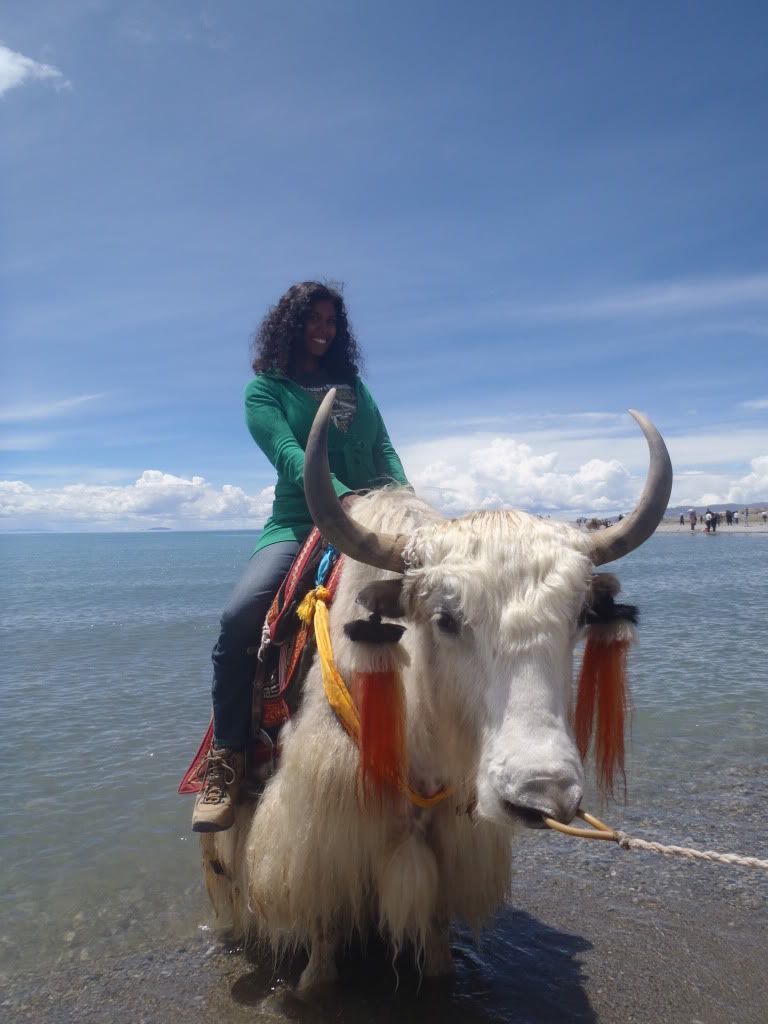
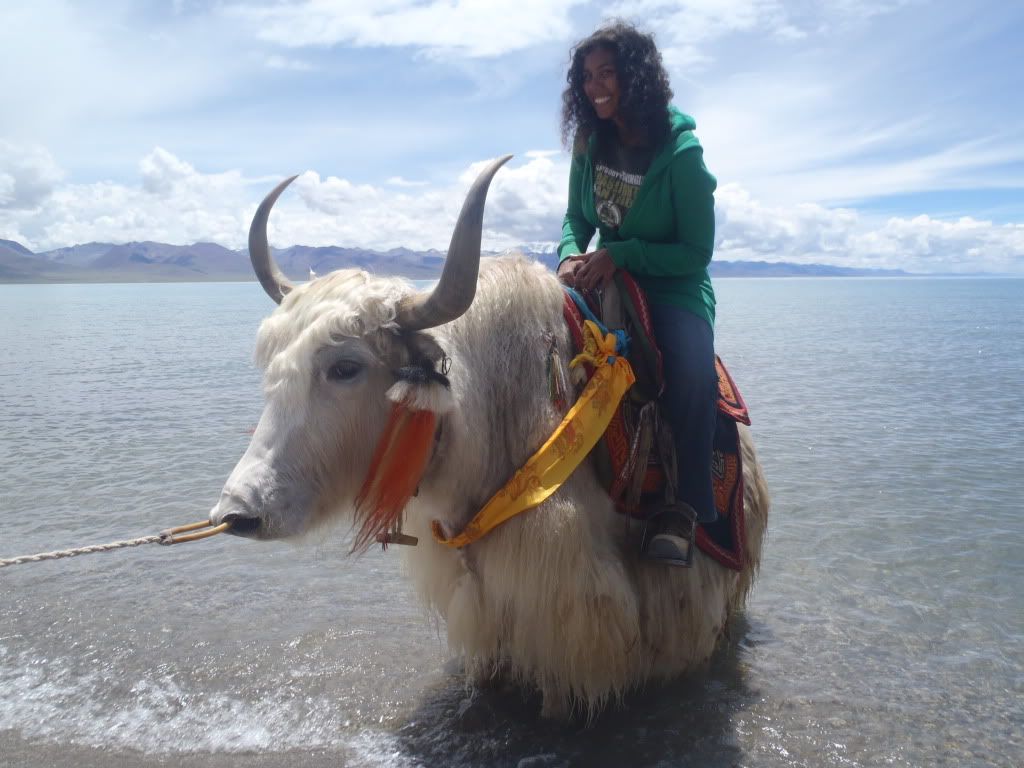
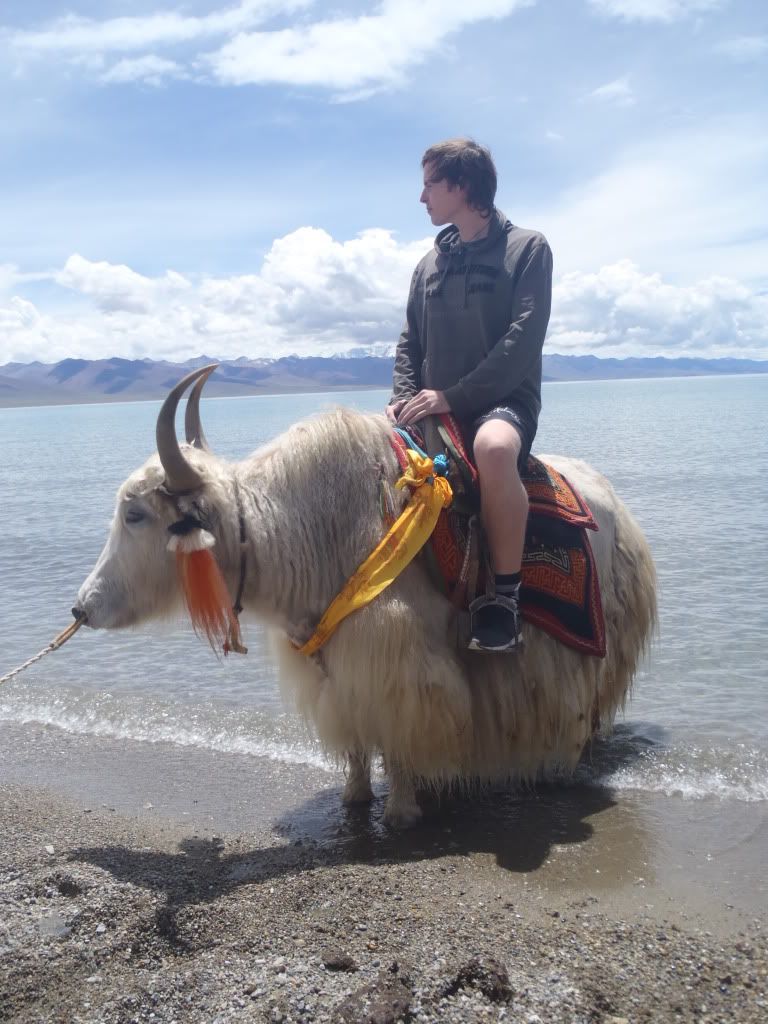
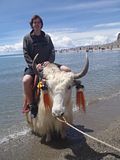
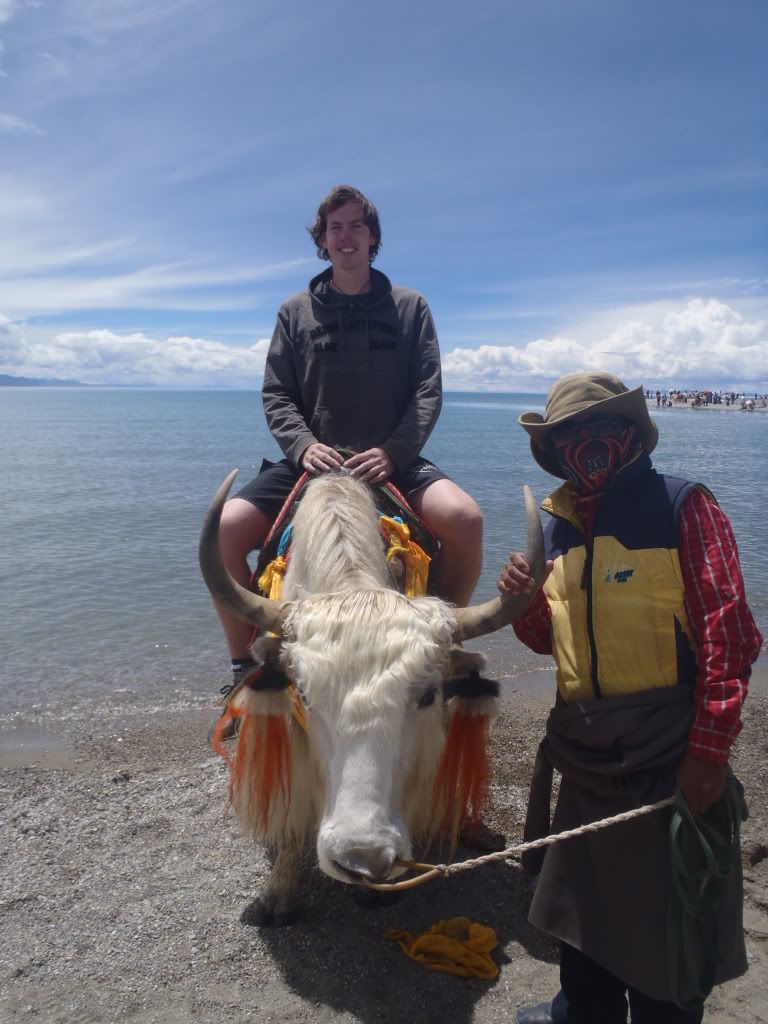
After paying the Tibetan we walked down the stony beach taking in the breath-taking views. Francesca rightfully asked if I could take some pictures of her and positioned herself on the rocks. What do you think of this beauty?
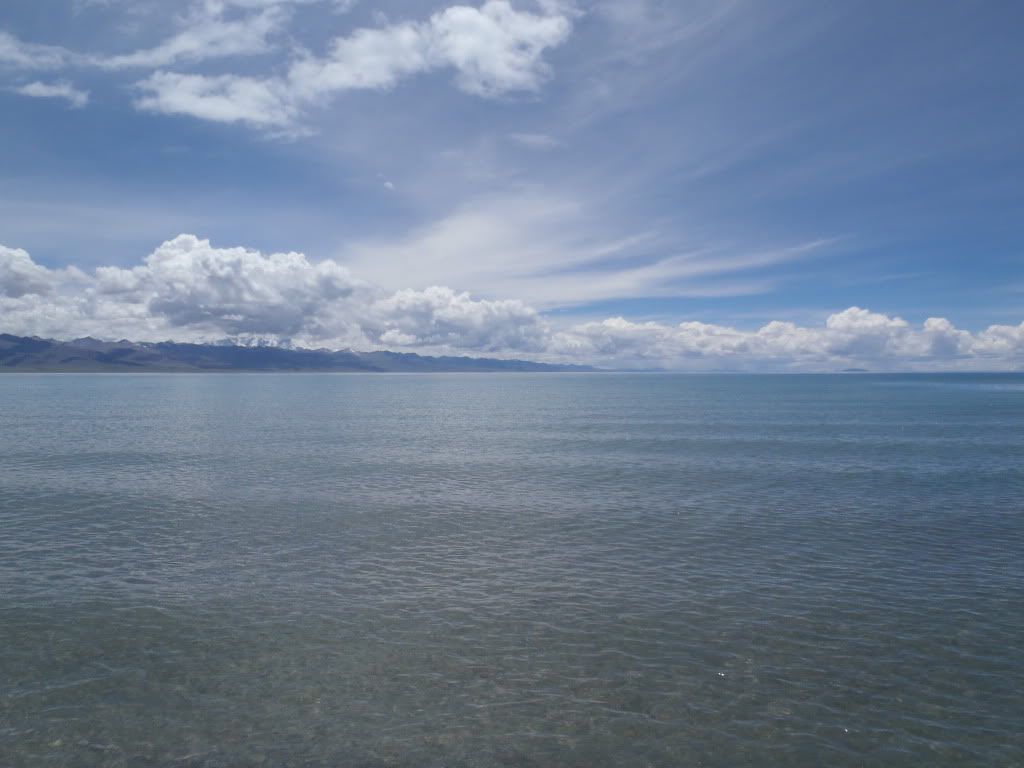
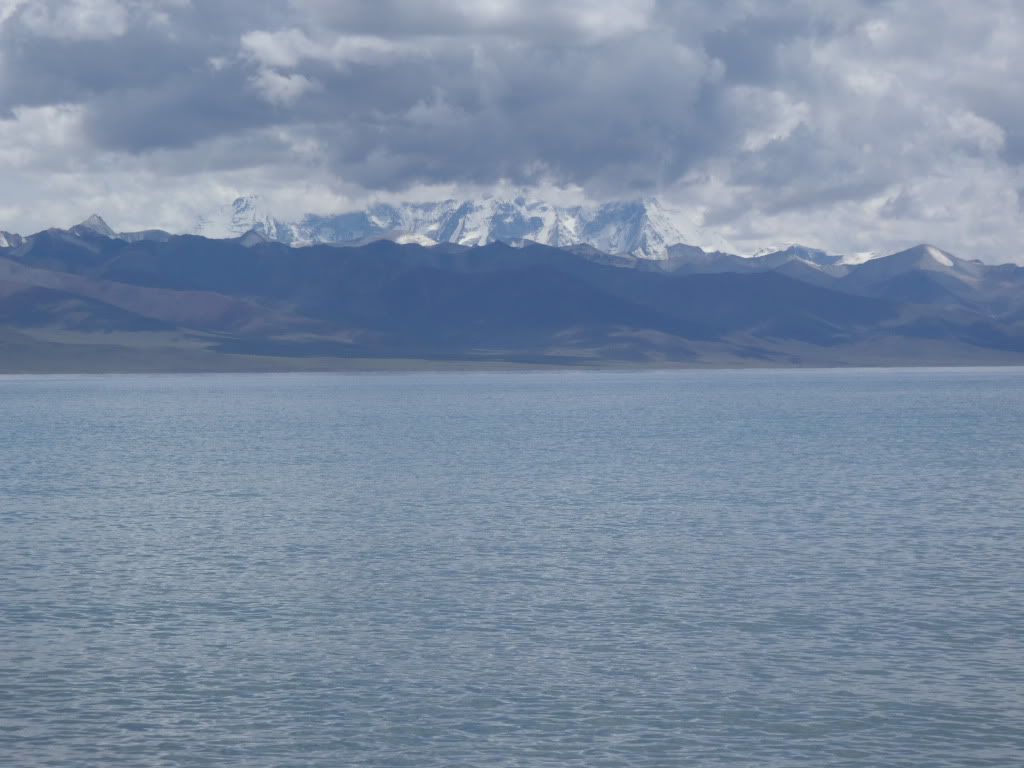
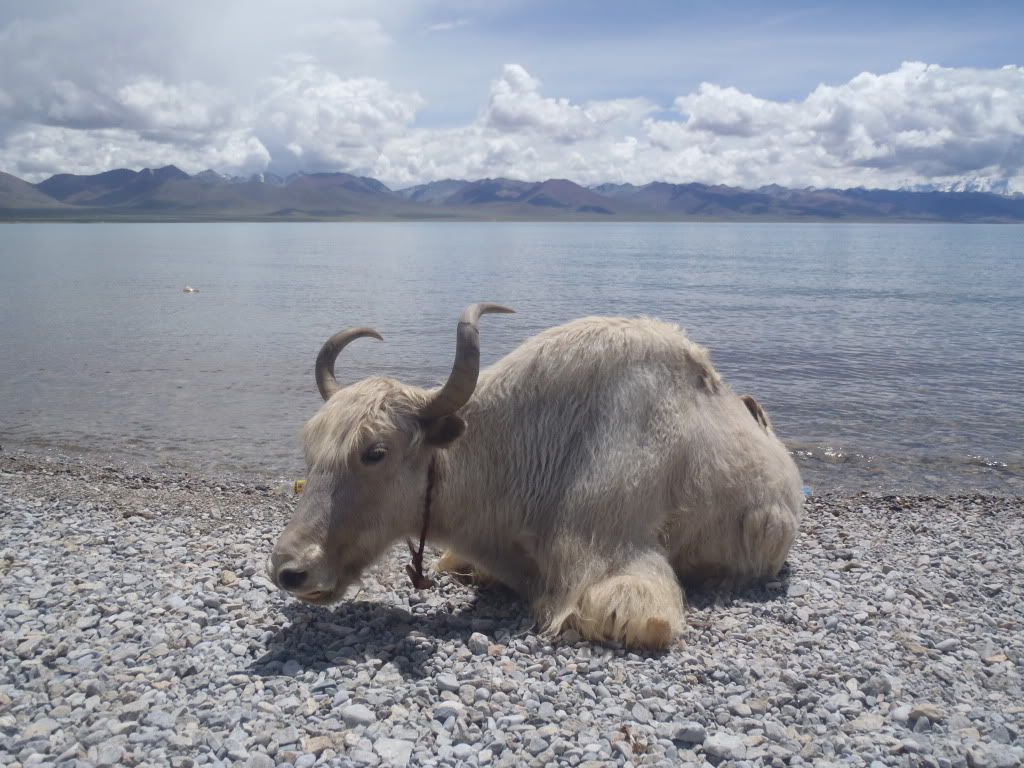
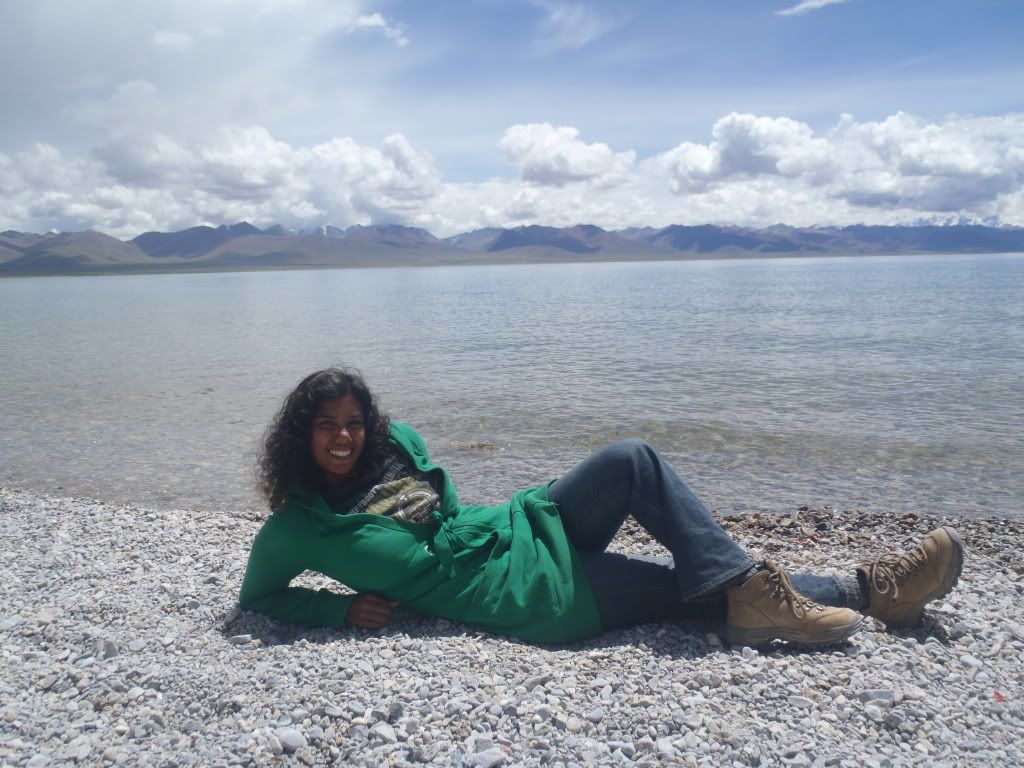

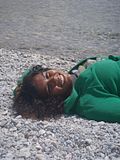
A little further up from the lake we discovered a little inhabited cave with some Buddhist relics. We paid our respects to Buddha and kept walking. More prayer-flags soon surrounded us and begged for another photo shoot. The flags already gave it away to the attentive reader, but Tibetans obviously consider Nam-tso a sacred lake. There’s a 21-day kora (a cleansing walk) around the lake. Needless to say, Nam-tso also had its own little monastery. Surprisingly, there was no entrance fee. Inside we found out why: there wasn’t much inside. We glanced at the few statues, and exited to head for our room. Near the guesthouse we spotted a grazing yak. I tried to get Francesca as close to it as possible, but every time she got in a perfect position the yak let out a loud, short and aggressive grunt leaving Francesca running for my arms. Since we’d already reached our yak-quota for the day we let this one win.
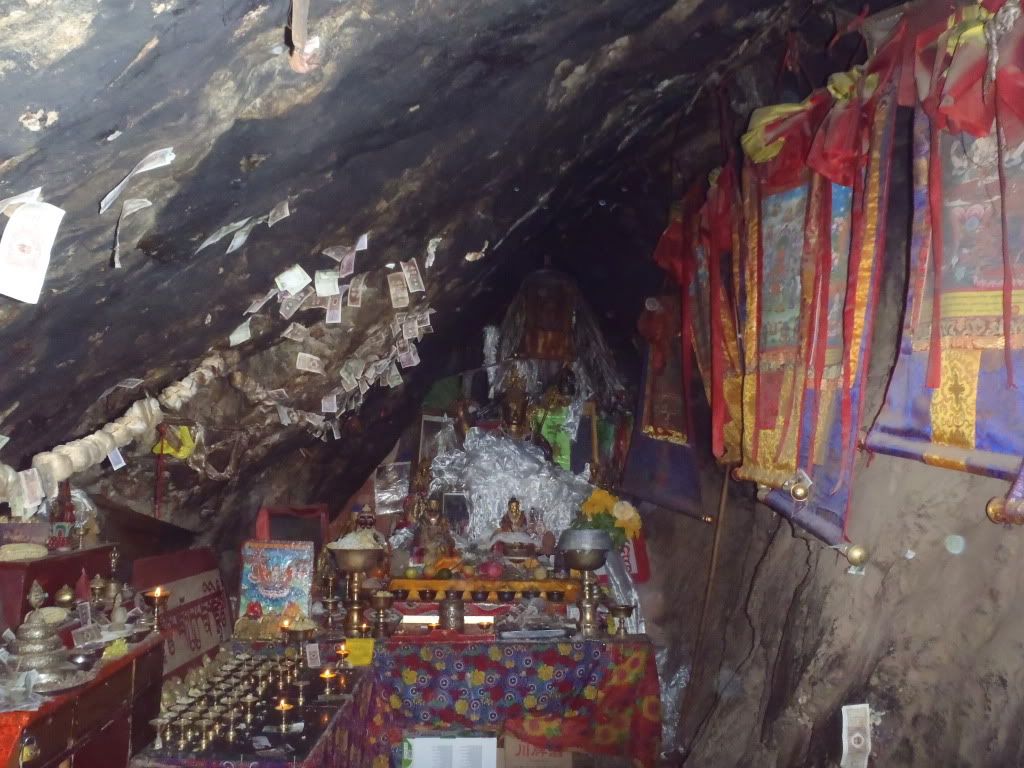
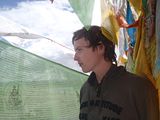

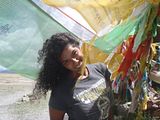
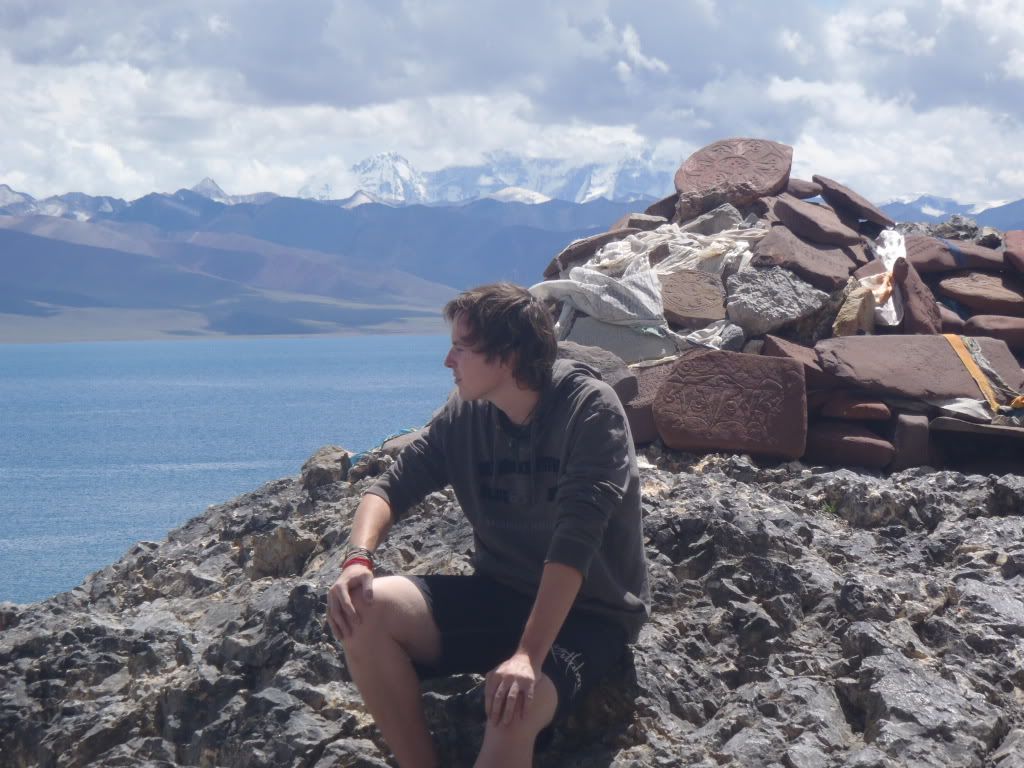
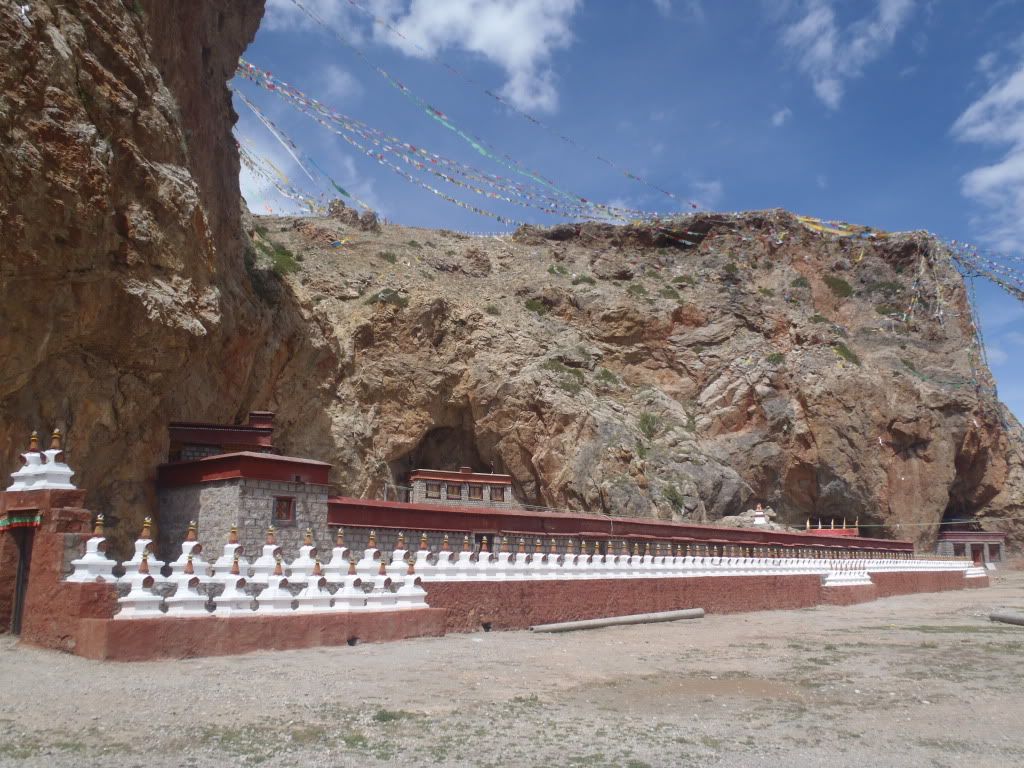

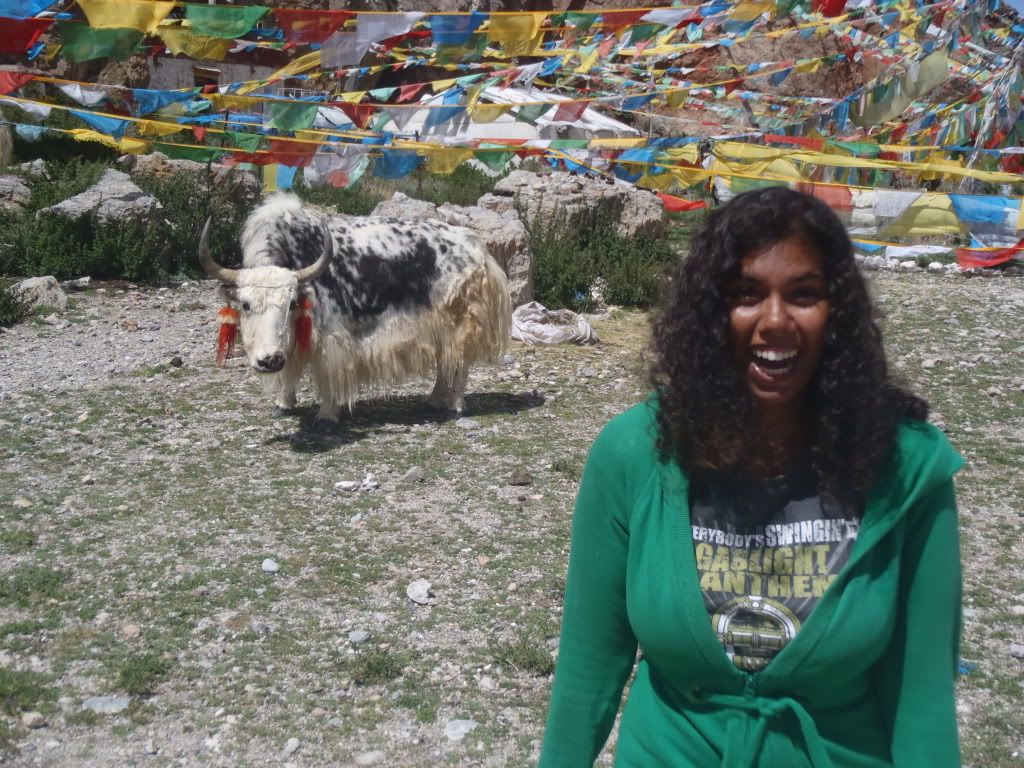
Later that afternoon Francesca and I tried to piece a meal together from the rather monotonous menu the Sheep Hotel provided. We decided on some naan with sliced chicken and celery to make our own sandwiches. Dinner tasted surprisingly good that way. Sleep that night turned out to be a bit of a problem. The presence of humans had inevitably led to the arrival of a horde of stray dogs. The saying ‘the dogs rule the streets at night’ that we’d come across back on Bali could be applied here once again. From about 10:00 PM until roughly 2:00 AM a cacophony of barking dogs surrounded us and left us with little time for shut-eye.
Regardless of the shortage of sleep we had to get up that next day to drive back to Lhasa. On our way back to Damshong Francesca and I wondered if we could check out one of the nomads’ tents set up near the road. Ray told us it’s officially not allowed to pay them a visit since it’s a source of income for the nomads, something the Chinese want to prevent to keep them poor. Ray and Power broke that rule for us and pulled over anyway.

It was 10:00 AM on the 14th of August and we were invited into yak-hair tent. Just outside of the tent we’d seen some yak cheese being dried. Before entering the tent we were greeted by Mr. Nyima, the head of the family. It’s a Tibetan tradition to meet your guests outside your house before you ask them in. He led us inside and introduced us to the rest of the family: his wife and two kids. We learned through Ray the parents were in their 40s, with the daughter and son aged 11 and 10 respectively. The family name means ‘Sunday’ – it’s a common practice of Tibetans to be named after days of the week.

The family had us sit down on the floor of their surprisingly warm and comfortable tent. The mother and daughter were churning yak milk to make yak butter, whilst the father offered us bowl of yogurt. I really enjoyed trying the home-made yogurt, whilst Francesca only found it edible after adding a bunch of sugar. The mother opened a bag of sweet candies they’d purchased from the market to make for a good meal. Furthermore, we were offered yak butter tea. Yak butter tea had been on our to-try-list, so this was the perfect chance. The tea is a mix of yak butter, salt and black tea. It makes for a rather rich mouthful of hot, salty milk. I didn’t think it was that bad, but wouldn’t drink it for fun. Francesca ‘s opinion was a little worse than mine.
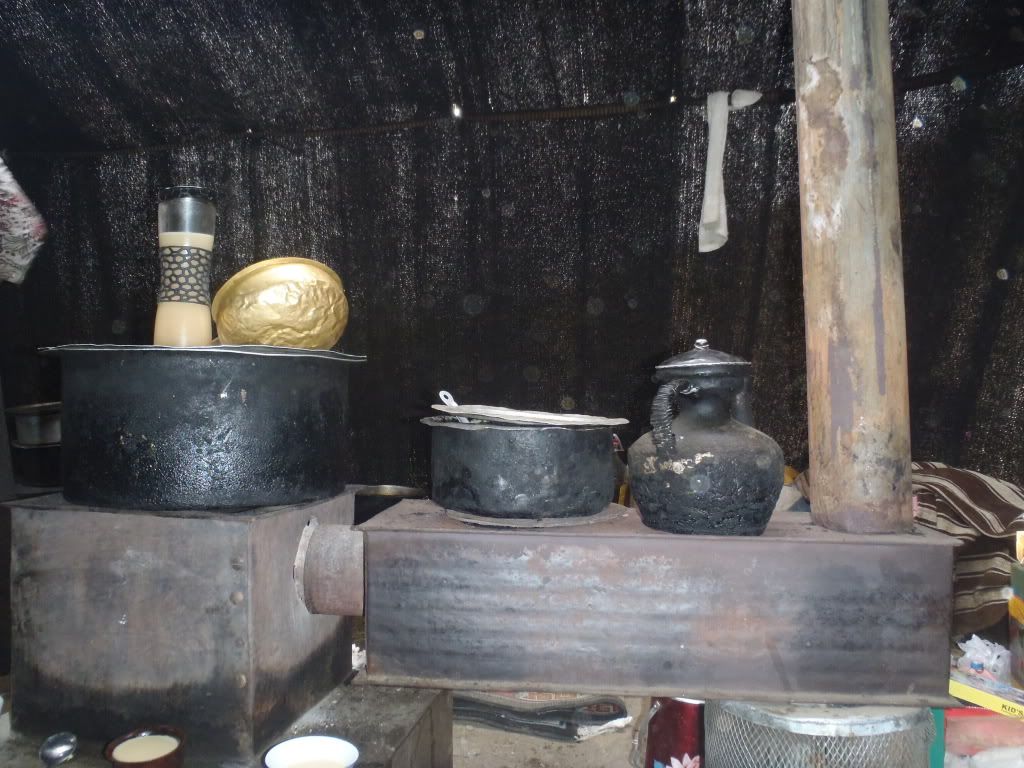
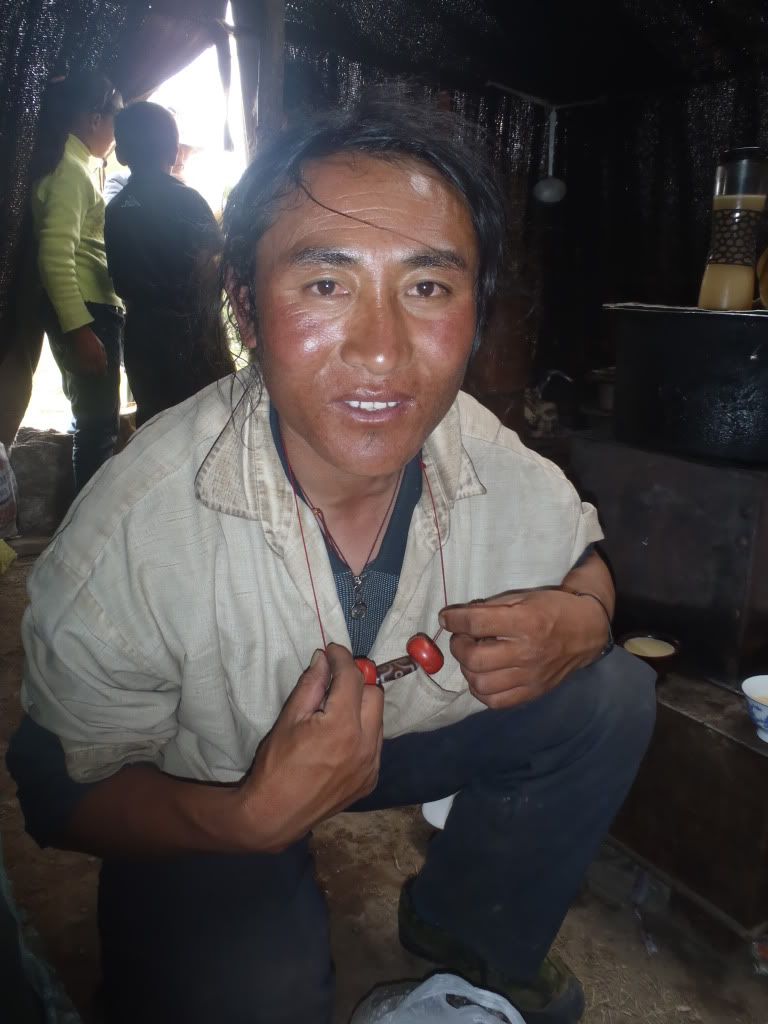
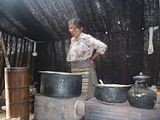
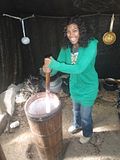
Ray also told us the family owned about 60 yaks, a relatively small number compared to other nomads. The mother complained there’d been too little rain this year, resulting in poor grass and less milk from the yaks. Since the main source of income for the nomads comes from the yak-produce they sell it’d be a bad year for them. When the family showed us a sling made of yak hair – made in about 24 hours – we were quite eager to help them through the winter by buying this awesome souvenir off them. The father and son even popped out of the tent to show us how our new purchase works, shooting small stones impressively far away. Ray grabbed the camera off us to take a picture of Francesca and me with the father and daughter. Notice how I’m bending my legs to look shorter; the dad wanted to stand on a rock at first!

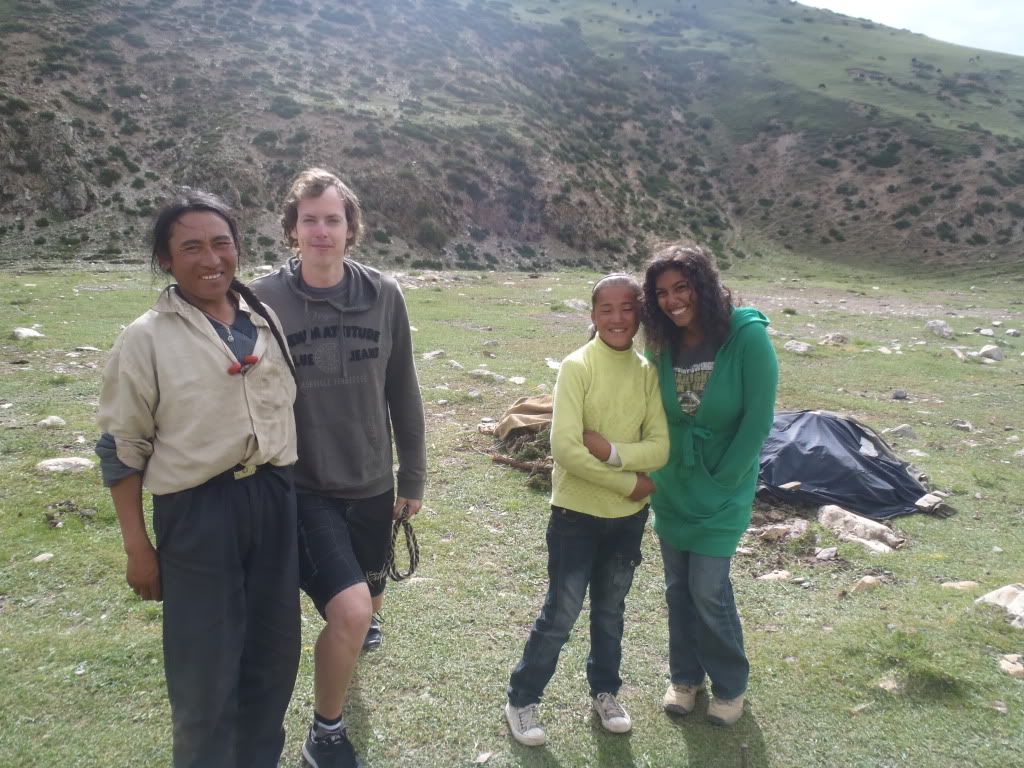
We had to say goodbye to the nomad family at this point, and waved until they disappeared out of sight. What an awesome experience! Ray added a little information to the wealth we’d already gained, telling us the nomads trek the same circle every year, staying in one place for no more than 3 months. As the temperature drops, so do the nomads, as they trek to lower grounds. We were also surprised to learn a stunning 40% of the Tibetan population is still nomadic, with the majority of them still illiterate. The kids do go to school in nearby Damshong, sadly learning Chinese as their first language. Luckily their parents make sure Tibetan is really their mother tongue.
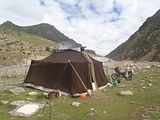
As we made our way further down the pass into the valley I spotted some movement in the grass besides the road. I’d seen the little creatures before and asked Ray about them. Ray’d said they were “a kind of mice that were also rabbits.” We later looked the creatures up and found out they’re called ‘pika.’ Pika are indeed half-mouse half-hare rodents, vital to the Tibetan plateau’s eco-system. Whereas Tibetans consider them pests in some areas since they eat all the grass, causing erosion, they’re in fact the major source of food for nearly all predators on the plateau. Keep your pika alive, Tibet! Besides, they look awesome!

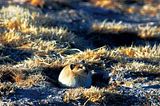
The rest of the drive back to Lhasa was uneventful. Once we reached the city again we got our first glance at the intensely impressive Potala Palace, the former home of the Dalai Lama. Before returning to the hotel we tried out the food at the Lhasa Kitchen, where Francesca ate a pretty decent cheese pizza and I had an average vegetable sandwich. We said goodbye to Ray, and walked back to the Rama Kharpo slowly, enjoying our stroll on Barkhor Street.
We spent most of the way to Nagchu firing questions at Ray and writing everything down in our notebook. Whenever we were contemplating something or thinking about our next question we’d stare out the windows of the car, admiring the awe-inspiring views of the mountains all around us. Now follows a summary of some (we’ll discuss our talks about Bon and Buddhism in other posts) of the interesting things Ray told us:


- Tibet consists of three parts: the Tibet Autonomous Region (Lhasa and surroundings), Amdo and Kham. The latter two sadly are part of Chinese provinces. Not that the T.A.R. is that much better off…
- There are only about 6 million Tibetans living in all of the regions of Tibet. Another 100,000 live in exile elsewhere on the planet (mainly Nepal and India).
- The three Tibetan provinces together are three times bigger than France.
- The Tibetan plateau is actually a pretty poor place to grow things. The height, lack of water and cold prevent the production of rice. It’s no surprise the staple food is roasted barley (called ‘tsampa’), along with most yak products. Introduced foods such as potatoes, tomatoes, cabbages, radishes, onions and garlic can now be grown as well, but have obviously not been around for very long.
- On the other hand, 47% of the world drinks water from a Tibetan source.
- A mere 2% of Tibetans own a car, with the far majority of those driving in Lhasa.
- Only 5% of all Tibetans have access to (Chinese-controlled) internet.
- Older generations of Tibetans have been very disillusioned by the past decades; it’s the younger generations that brought back a revival of Tibetan culture.
- Playing children used to call ‘the enemy’ ‘Japanese;’ nowadays the bad guys are always ‘Chinese.’
- Guiding is considered a middle class job, whereas being a doctor or traffic police officer is considered much better. The former because you help other people, the latter because of the decent pay, but better bribes.
Finally, around 11:30 AM we got to see our first yaks, Tibet’s large cow-like herbivores. Since we’d already eaten parts of the yak it had been high time to actually see one first-hand. They are so much cooler than plain old cows back at home! Around noon we came across our first other ‘village.’ Horribly Chinese-looking Damshong would be our lunch-stop. A Chinese-only menu meant we had to get Ray to order us food, without knowing the prices. We ended up with a horribly overpriced nearly chicken-less spicy chicken dish and a watery soup with some lettuce in it. What a rip-off! And what’s more, Francesca really needed to go to the bathroom. The toilet-situation had already been dyer in Lhasa, but what awaited us outside of the city proved to be absolute horror. Skip the next picture if you still need to eat!



We left Damshong in a hurry, eager to finally make it to Nagchu. Since the roads have no speed radars it’s technically impossible to prevent speeding on Tibetan roads. The clever Chinese politicians decided it would be a good idea to set up checkpoints along the way and having drivers get stamps every time they pass one. They’d then have to take at least x amount of minutes to make it to the next checkpoint. If they’d end up being faster they’d be fined. Sounds smart, right? Unfortunately most drivers still speed to the next checkpoint, where they end up parking their car for some time before continuing their drive. Ray rightfully said this is actually more dangerous, since there’s no lighting by the roads, making the whole situation more accident-prone. Of course, the Chinese officials don’t care and leave the situation as is.
Our drive continued, with yaks crossing the roads, and a little bit later a stop to take some pictures of Tibetan nomads and their herd of yaks. I got out of the car to have a closer look at these beasts of burden. The first thing I noticed is that yaks are surprisingly agile animals, much more like goats than cows. Whilst they once roamed the Tibetan plateau in large herds numbers of wild yaks have dropped sharply and are hard to find nowadays. Whilst domesticated yaks are still bigger than normal cows they’re not as enormous as their wild counterparts. Wild yaks can reach a height of 2.2 meters and a weight of 1000 kg; domesticated ones are only about half that weight. Ray told us yaks are an integral part of Tibetan culture, as they are often used as pack animals for long trips. Yaks are also a great source of food, because they provide meat and dairy-products as well as insulating fur, long hair and manure – once dried a great source of fuel. I later found out yak meat is actually one of the healthiest red meats, being over 95% fat free and full of protein. No surprise with the diet of grass and all the exercise these beasts get!



Around 3:30 PM we finally reached the city of Nagchu, perched at a height of 4500 meters above sea level, making it one of Tibet’s highest cities. Nagchu is also, unsurprisingly, one of the coldest and windiest cities in Tibet, with oxygen levels just 60% of those found at sea level. Suddenly my shorts weren’t quite as nice anymore! Our first task was to find a hotel for the coming two nights. We hadn’t pre-booked any hotels outside of Lhasa, figuring it would be easy to find accommodation. As we popped into a few places Ray and I found out it’d be much more difficult and pricey to find something here. Most places had been booked up by tour-groups and other visitors… After 30 minutes of driving around Ray finally found a place that would discount their room enough for us to accept the offer. We lay down for a little bit, because we both suffered a little from the height and thin air.
Around 4:30 PM we met Ray once again, this time to go check out the festival. A short drive took us to the parking area, where we said goodbye to Power and walked towards the terrain proper. We were met with looks and stares by the locals. Not quite as annoying as the Chinese, but still quite awkward for us. As we passed a large number of tents – apparently housing as many as 10,000 nomads – a large arena appeared in front of us. Ray told us we wouldn’t be able to get in without a special ‘Tourist Card,’ which we could only obtain from a police officer. It didn’t take too long for one to show up. The kind man told Ray the festival had pretty much ended for the day, so we would be allowed to check out the last bit for free and only had to pay for the next day. Very kind! We thanked the man thoroughly and headed for the arena.
The three of us climbed a few stairs and sat down in the large stadium. The first thing I noticed was the gorgeous view. Behind the stadium the grassy hills were being grazed by a herd of yaks, and above it the blue sky carried a few large, white clouds with ease. Around 5:00 PM some dancing ensued, which Francesca found interesting, but left us both wondering how traditionally Tibetan it was. We watched for about 15 minutes after which the show ended and we got to make our way back to the hotel. Francesca had attracted two fans during our stay in the stadium: two girls kept on following her. I tried to take a picture of them, but they were a little shy. Ray told us Tibetans tend to be okay with having their photo taken, unless you ask them. They’d rather say no if you ask. Having been on the receiving end of this deal quite a bit in China we both felt uncomfortable just pointing our camera at the Tibetans.




That evening I ordered Francesca a sweet and sour chicken, and myself a noodle soup and some steamed buns. After a good 45 minute wait an enormous plate of chicken arrived, along with a small bowl of soup. Francesca gorged on the delicious chicken whilst I had to make some chicken sandwiches to satisfy my appetite. We watched one of Francesca’s childhood movie favorites ‘Pete & His Dragon’ with our food on our laps. Unbeknownst to both of us the plate of chicken ended up leaking on the white sheets, leaving a huge, orange mark that I could not get rid of. Fearing a fine we hid the sheets and replaced them with some extras we’d found in the closet.
Sleep came easy after the tiresome drive and altitude gain. The next morning we had a shower and met Ray around 9:00 AM for a full day at the festival. The program offered a variety of horse racing, weight lifting, singing and dancing. Sadly we’d have to miss the yak racing, something I would have loved to see. Regardless, the program promised plenty of variety. However, before sitting down for the entertainment we needed sustenance. Ray led us inside a large nomad-tent, where we could choose between yak momo and noodle soup. Of course we chose to have the lady make us some hand-made momo. Ray joined us in our yak eating feast and finished a plate by himself as well.

Around 9:30 AM we found our spots and joined all the locals on the concrete benches of the horse racing stadium. Throughout the day we took pictures of all the colorful Tibetans that had decided to come see the show as well. It was great to see how some were in full traditional outfits, whilst others wore completely modern, even hip clothing. Of course the Chinese army was also present, obstinately parking a row of soldiers in the middle of the field, with patrols going around the stadium and fully armored riot police on stand-by. Complete overkill and frankly quite scary for the poor Tibetans that all just came to enjoy their tradition.


Here’s a little description of the history of the festival from chinatravel.net: “In the 17th century, the Horse Racing Festival was established as a way to bring the area's nomads into the young township to exchange ideas, inventions and goods—a kind of nomad Expo. Within the next century the gathering had become the most popular and important event of its kind in the Northern Plateau. Little changed for almost two hundred years in and around Nagchu, until the Cultural Revolution hit Tibet and the culturally significant Horse Racing Festival was banned. The festival has recently been revived, delighting increasing numbers of tourists every year along with the remaining nomads, many of whom are as likely to roll into town on a motorcycle as they are to arrive on horseback.”

After a mandatory and long introduction in Chinese and Tibetan the horse racing got underway. Groups of about 10 colorfully decorated horses and their equally colorful, prepubescent riders were brought out onto the track and somewhat haphazardly released to race each other around the roughly 1 kilometer long ring for three rounds. Ray told us there’d be about 12 races, after which the winners of said races would go head-to-head for the grand prize. The three of us watched the races with great interest – Ray had only been here once before – seeing some close finishes. Other races saw serious crashes, one of which had a horse and its rider crash into one of the giant balloons that’d been put up all around the track. Some races seemed to have clear winners, but ended up being reset as horses tried to exit the track through a gate on the east-side of the track. Gasps would surround us as people got up to see what was going on. Once the winner crossed the finish line designated guys would run after the victor to give him a scarf and take him to the winners’ area. Of course the horses would still be going at full speed, leaving the men running after the horses for quite some time.










Around noon all winners had been gathered in a separate area. The organization had wisely decided to take down the balloons. One of the people taking them down had a less than firm grasp on the cord and let the giant balloon go. Up, up and away! Just before 12:30 all the winners were gathered for the finale of the horse racing. I went down to the railing for a premium view of the race, making a video and taking many pictures of the great race. A group of about 6 horses stuck together for most of the race, even all stopping at the gate, only to continue their race a little later. A few minutes later rider 14 emerged victorious, winning his family great honor and a cool, new motorbike.





A break followed as the stadium was emptied of people, who all went their own way to score a meal. It was unknown to both Ray and locals he asked what time the weight-lifting would start, which made us wonder if we should head back to the hotel, or stay around the festival for lunch. Ray and I ended up eating a momo soup in one of the tents, whilst Francesca skipped that meal hoping for something better. We eventually found her a bag of popcorn, skewered potatoes and meat, which we combined with some buns I’d already bought for her.
Ray, in the mean time, had dozed off on the steps in front of the stadium. There was no information available about the schedule and nothing happened for a long time. It took until 3:00 PM before the gates were opened again. Sadly, there’d be no weight-lifting… just more dancing and singing. I listened to the lengthy introductions, followed by some awful Tibetan singing, and equally bad dancing. Francesca and Ray were a little more interested. I handed over the camera to my girlfriend and walked off to stand in the shade for a while. Immediately some of the security wondered what I was doing, so I rubbed my legs and belly, indicating I was stretching my legs and had a bit of a stomach ache. After half an hour I returned to Francesca and Ray, who’d been watching all the dances. I sat down for the last 5 minutes and hoped for a speedy end to the visual agony. Then, out of the blue, a cop appeared, pointing at me. An English-speaking Tibetan came and sat next to me asking me if I was okay. Apparently they’d thought I was in bad shape and called for a doctor! I reassured the man I was doing okay and they left again. Ray told us a tourist had fallen very ill during one of the previous years, so the staff had been instructed to check all foreigners with apparent problems.



Around 5:00 PM we left and headed for the hotel. Francesca and I fell asleep for a while, only getting up to order another portion of sweet and sour chicken and steamed buns for dinner. Another enormous plate arrived around 9:00 PM, after which the bags needed packing and the two of us needed sleep.

The following morning, the 13th of August would see us driving back to Damshong. From there we headed west to Nam-tso Lake, our next destination on the itinerary. Again with mountains on both sides of the road the drive took us higher and higher. Tibetans place prayer-flags along windy passes to fill the air with the printed Buddhist mantras, gaining some free merit in doing so. We stopped near one of the larger prayer-poles and I ran out to take some pictures from inside. Standing amidst the flags, looking out at the world was impressive and made for some great pictures. I even found an abandoned Chinese police-hat that sadly no longer had a badge.


Around 1:00 PM we reached the entrance gate to the Nam-tso area. The pricey tickets had to be bought, leaving us with the bitter taste of knowing we were supporting the Chinese directly by buying them. 15 minutes later we’d reached the Nagenla Pass, the highest point of this day’s drive at the dizzying altitude of 5150 meters. I got out of the car to take some pictures of the lake in the distance. Unfortunately my shorts now really proved insufficient and I had to run back to the car to warm up. Going downhill the enormous lake came closer and closer. We learned from Ray that Nam-tso (‘Heavenly Lake’) covers an area of 1920 square kilometers, making it the second-largest salt lake in China. Furthermore, it’s incorrectly advertised as the highest lake in the world at an altitude of 4718 meters. Regardless, thanks to the altitude the sacred lake has a near-perfect turquoise color. Combined with the stunning ranges in the background it makes the whole place quite photogenic.

Just after 2:00 PM Power pulled up near some very basic guesthouses right beside the lake. Ray told us to explore the lake by ourselves, which we were fine with. I put our bags in the room, whilst Francesca headed out to find the toilet. About 10 minutes later she came back and the expression on her face told me it hadn’t been pretty. Since I needed to go as well I followed her back to the building. Just getting within smelling range of the cot made me want to run back in the opposite direction straightaway. Mother Nature was suddenly a much better option as a replacement toilet.
With that adventure out of the way the exploration of Nam-tso could finally start. We headed for a stupa in the distance. It was surrounded by a wall of rocks. At first glance they looked rather plain, but after closer inspection we noticed they’d been inscribed with mantras. On our way to the most picturesque viewpoint of the lake we passed another prayer-flag-pole, where I got some cool pictures of Francesca. We passed some people with horses and soon reached the water’s edge. A large contingent of Chinese tourists made the experience slightly annoying, especially after we some particularly ignorant Han Chinese making peace signs.




Luckily we were quickly distracted by a sign that said “Riding yak into the lake to take photos, pay 10 Yuan.” We’d both wanted pictures with a yak, so this was the perfect opportunity. With the impressive Tangula Shan mountain range in the background – highest peak 7111 meters! – we couldn’t have wished for a better spot. I haggled with one of the locals for a while to get a good price for our yak-pictures. Francesca mounted the big white beast first and I took as many pictures as I could. We then switched roles and Francesca also produced some great shots of me.






After paying the Tibetan we walked down the stony beach taking in the breath-taking views. Francesca rightfully asked if I could take some pictures of her and positioned herself on the rocks. What do you think of this beauty?






A little further up from the lake we discovered a little inhabited cave with some Buddhist relics. We paid our respects to Buddha and kept walking. More prayer-flags soon surrounded us and begged for another photo shoot. The flags already gave it away to the attentive reader, but Tibetans obviously consider Nam-tso a sacred lake. There’s a 21-day kora (a cleansing walk) around the lake. Needless to say, Nam-tso also had its own little monastery. Surprisingly, there was no entrance fee. Inside we found out why: there wasn’t much inside. We glanced at the few statues, and exited to head for our room. Near the guesthouse we spotted a grazing yak. I tried to get Francesca as close to it as possible, but every time she got in a perfect position the yak let out a loud, short and aggressive grunt leaving Francesca running for my arms. Since we’d already reached our yak-quota for the day we let this one win.








Later that afternoon Francesca and I tried to piece a meal together from the rather monotonous menu the Sheep Hotel provided. We decided on some naan with sliced chicken and celery to make our own sandwiches. Dinner tasted surprisingly good that way. Sleep that night turned out to be a bit of a problem. The presence of humans had inevitably led to the arrival of a horde of stray dogs. The saying ‘the dogs rule the streets at night’ that we’d come across back on Bali could be applied here once again. From about 10:00 PM until roughly 2:00 AM a cacophony of barking dogs surrounded us and left us with little time for shut-eye.
Regardless of the shortage of sleep we had to get up that next day to drive back to Lhasa. On our way back to Damshong Francesca and I wondered if we could check out one of the nomads’ tents set up near the road. Ray told us it’s officially not allowed to pay them a visit since it’s a source of income for the nomads, something the Chinese want to prevent to keep them poor. Ray and Power broke that rule for us and pulled over anyway.

It was 10:00 AM on the 14th of August and we were invited into yak-hair tent. Just outside of the tent we’d seen some yak cheese being dried. Before entering the tent we were greeted by Mr. Nyima, the head of the family. It’s a Tibetan tradition to meet your guests outside your house before you ask them in. He led us inside and introduced us to the rest of the family: his wife and two kids. We learned through Ray the parents were in their 40s, with the daughter and son aged 11 and 10 respectively. The family name means ‘Sunday’ – it’s a common practice of Tibetans to be named after days of the week.

The family had us sit down on the floor of their surprisingly warm and comfortable tent. The mother and daughter were churning yak milk to make yak butter, whilst the father offered us bowl of yogurt. I really enjoyed trying the home-made yogurt, whilst Francesca only found it edible after adding a bunch of sugar. The mother opened a bag of sweet candies they’d purchased from the market to make for a good meal. Furthermore, we were offered yak butter tea. Yak butter tea had been on our to-try-list, so this was the perfect chance. The tea is a mix of yak butter, salt and black tea. It makes for a rather rich mouthful of hot, salty milk. I didn’t think it was that bad, but wouldn’t drink it for fun. Francesca ‘s opinion was a little worse than mine.




Ray also told us the family owned about 60 yaks, a relatively small number compared to other nomads. The mother complained there’d been too little rain this year, resulting in poor grass and less milk from the yaks. Since the main source of income for the nomads comes from the yak-produce they sell it’d be a bad year for them. When the family showed us a sling made of yak hair – made in about 24 hours – we were quite eager to help them through the winter by buying this awesome souvenir off them. The father and son even popped out of the tent to show us how our new purchase works, shooting small stones impressively far away. Ray grabbed the camera off us to take a picture of Francesca and me with the father and daughter. Notice how I’m bending my legs to look shorter; the dad wanted to stand on a rock at first!


We had to say goodbye to the nomad family at this point, and waved until they disappeared out of sight. What an awesome experience! Ray added a little information to the wealth we’d already gained, telling us the nomads trek the same circle every year, staying in one place for no more than 3 months. As the temperature drops, so do the nomads, as they trek to lower grounds. We were also surprised to learn a stunning 40% of the Tibetan population is still nomadic, with the majority of them still illiterate. The kids do go to school in nearby Damshong, sadly learning Chinese as their first language. Luckily their parents make sure Tibetan is really their mother tongue.

As we made our way further down the pass into the valley I spotted some movement in the grass besides the road. I’d seen the little creatures before and asked Ray about them. Ray’d said they were “a kind of mice that were also rabbits.” We later looked the creatures up and found out they’re called ‘pika.’ Pika are indeed half-mouse half-hare rodents, vital to the Tibetan plateau’s eco-system. Whereas Tibetans consider them pests in some areas since they eat all the grass, causing erosion, they’re in fact the major source of food for nearly all predators on the plateau. Keep your pika alive, Tibet! Besides, they look awesome!


The rest of the drive back to Lhasa was uneventful. Once we reached the city again we got our first glance at the intensely impressive Potala Palace, the former home of the Dalai Lama. Before returning to the hotel we tried out the food at the Lhasa Kitchen, where Francesca ate a pretty decent cheese pizza and I had an average vegetable sandwich. We said goodbye to Ray, and walked back to the Rama Kharpo slowly, enjoying our stroll on Barkhor Street.

0 Comments:
Post a Comment
<< Home